
Please add below. Older posts under News on top bar or in Search
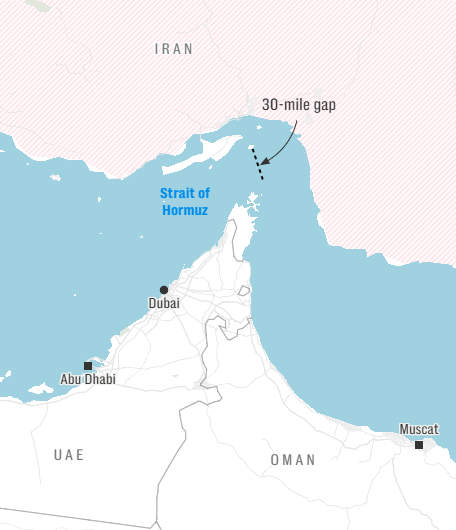
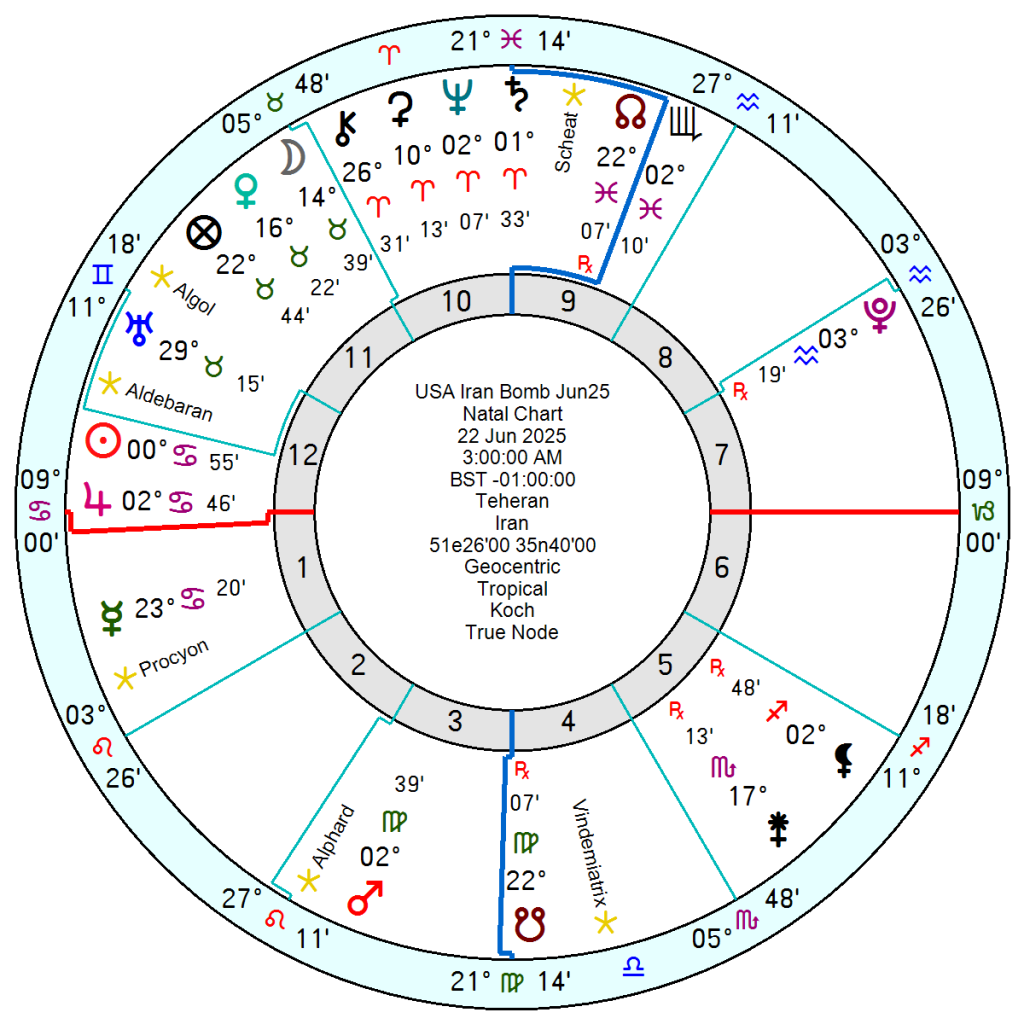
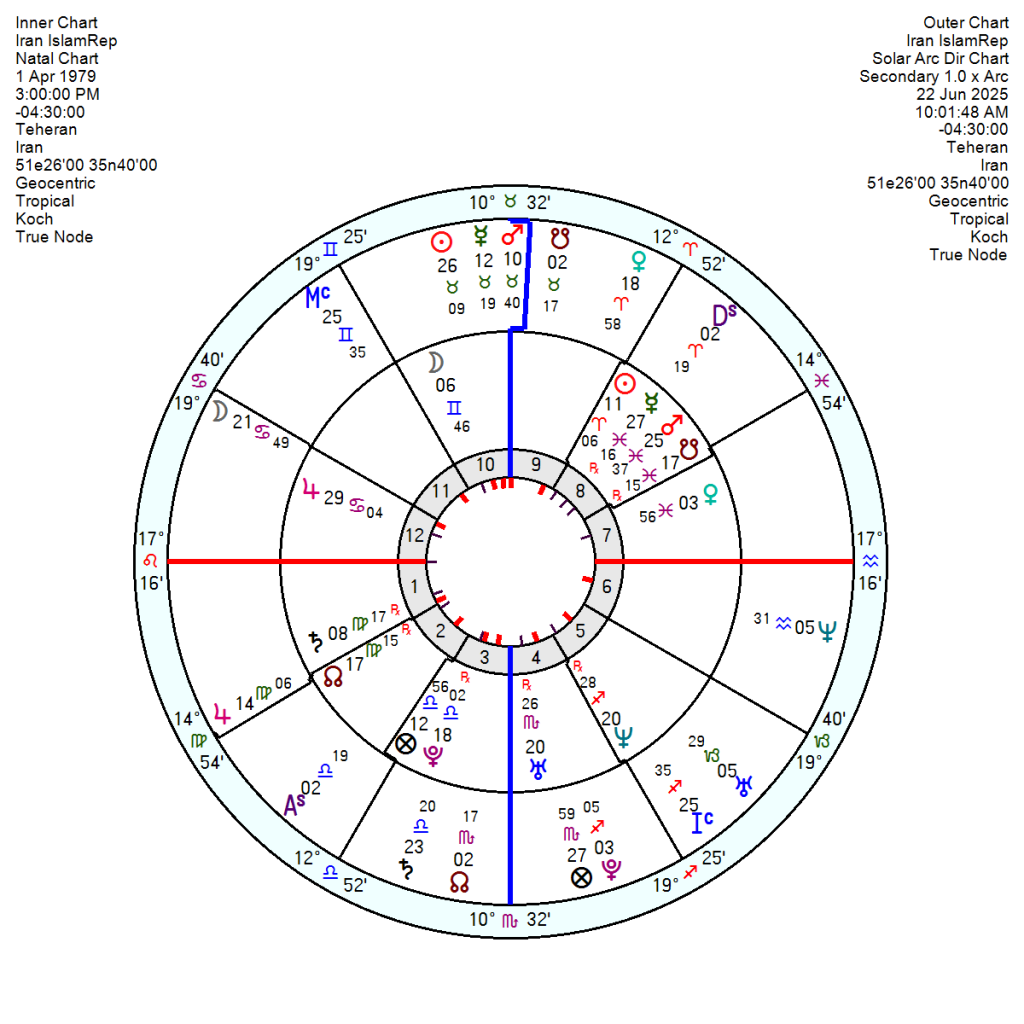

The USA joined Israel’s fight against Iran by sending in bombers to attack Iran’s nuclear sites. Happening around 3am Iran time, there were two yods of Sun Jupiter sextile Mars inconjunct Pluto – and Pluto sextile Saturn Neptune inconjunct Mars. A Plutonic yod can be coercive; a Martian yod rash and disruptive – and yods do suggest a game-changing phase.
Even MAGA supporters are split on Trump’s decision which could expose thousands of US military personnel across the Middle East to retaliation by Iran and its proxies in the region and goes against Trump’s campaign promises to avoid military entanglements. Conservative media personality Tucker Carlson said there was no justification for attacking Iran, with “zero credible intelligence” to suggest it was “anywhere near” building a nuclear bomb. Steve Bannon said Israel had “essentially forced President Trump’s hand” by starting a war with Iran, knowing it did not have the military capability to finish the job.
The Bombing chart also has the Sun just into Cancer conjunct Jupiter square Saturn Neptune = over hopeful and uncertain.
The Trump Term Inauguration chart has the Progressed Moon approaching a square to the Mars IC within weeks which does suggest heated debates and an aggravated electorate. What is notable are two midpoints – tr Uranus square the Sun/Neptune midpoint and tr Uranus square the Neptune/Pluto midpoint both exactly now – given the Neptune Pluto in particular is associated with nuclear issues; and Ebertin adds his hints of gloom with ‘hyper-sensitive nerves’, obsessions, maybe losses, emotional crises. There will be upheavals and upsets, changes of plan through July/August with tr Uranus moving into Gemini squaring two other key Trump Term midpoints.
The Iran 22 December 1501 chart is certainly showing maximum stress and disappointment over coming months with tr Uranus opposition the Pluto and tr Neptune Saturn square the late Sagittarius Sun into mid 2026.
The Iran 1501/Israel relationship chart has the ‘disaster/nuclear?’ tr Uranus opposition the composite Neptune into mid 2026. The USA/Iran 1501 is less obvious with a tricky-to-interpret tr Uranus conjunct the Jupiter in this July which (being optimistic) could point to a negotiated settlement and relief. Though tr Saturn square the Pluto into 2026 is blocked and heavy going.
Presumably the wager is that Iran and its proxies in the Middle East have been so weakened that the US intervention can be limited and successful, forcing Tehran to quickly seek a settlement rather than retaliating. But there is a risk of inflaming the Middle East further.
Brian Katulis, senior fellow at the Middle East Institute, a Washington think-tank said “It all depends on how the Iranian regime reacts — and it’s not clear what the regime’s capacities and will are at this point. [But] Iran’s network across the region remains operationally lethal, and it is able to sow more instability and terror if it chooses to do so.”
One hope would be that it might collapse the Iran Islamic Republic (the bearded mullahs) whom even the Iranians dislike. Founded 1 April 1979 3pm Teheran, there are signs of stress with the SA Pluto square Venus; SA Mars square the Midheaven; and SA Midheaven square Mars – an emotionally fraught time exactly now though not necessarily the end of the road.
Both the USA and Israel in relationship to the 1979 Iran Islamic Republic chart show continued bad feeling extending from this year and on for several years.
My own feeling (perhaps biased) is not so much that Netanyahu trapped Trump into taking action but more that Trump could not bear to be left on the sidelines (not centre of attention) when a major action was going down.
We wait, watch and see.
Latest: The Iranian parliament has approved the closure of the Strait of Hormuz – a key passage through which 20 per cent of global oil and gas demand flows. It would cause a sharp spike in prices and could temporarily restrict the ability of US warships to exit the Persian Gulf. Major oil producers, including Saudi Arabia and the UAE, rely on the waterway to access the open sea. The Chinese also rely on the Strait of Hormuz for their oil.
Marco Rubio, US Secretary of State said: “It’s economic suicide for them if they do it. It would hurt other countries’ economies a lot more than ours.”
See previous post 14 June 2025 Iran 1501

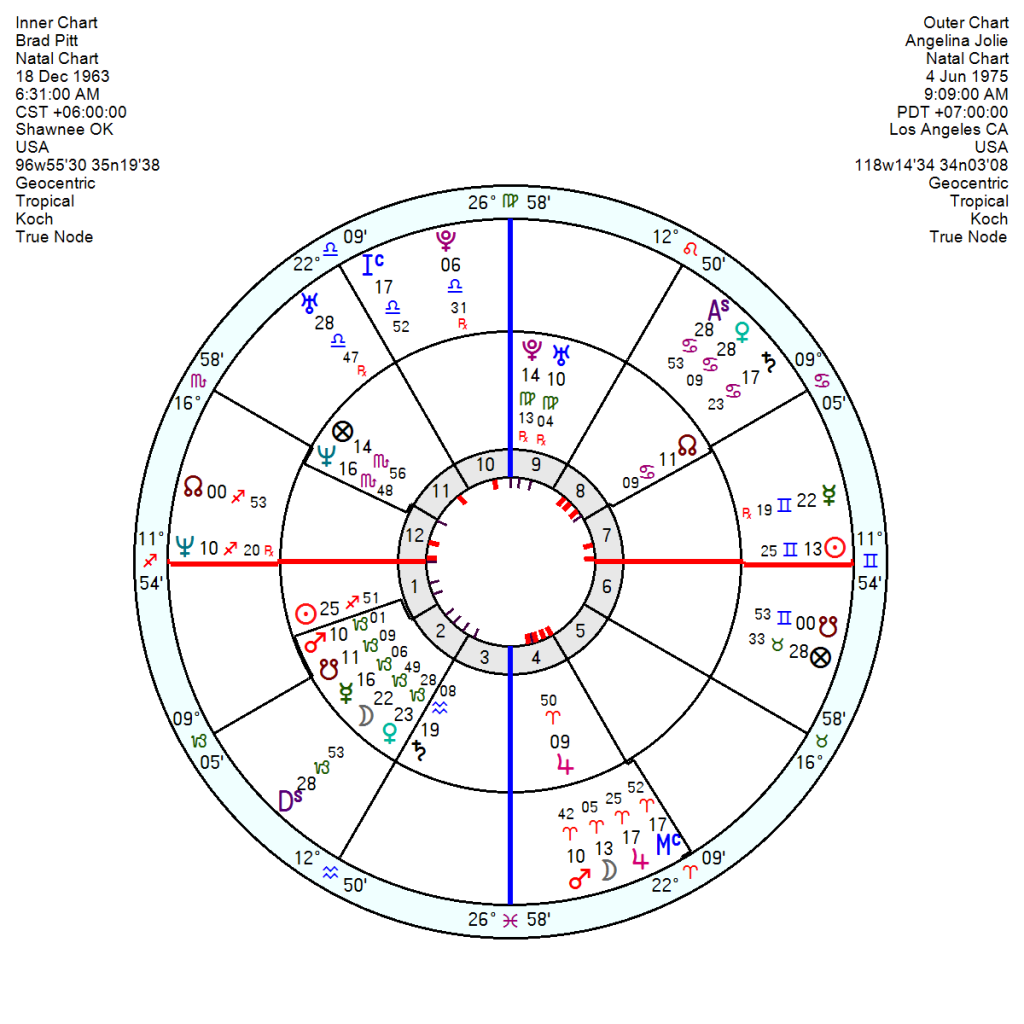

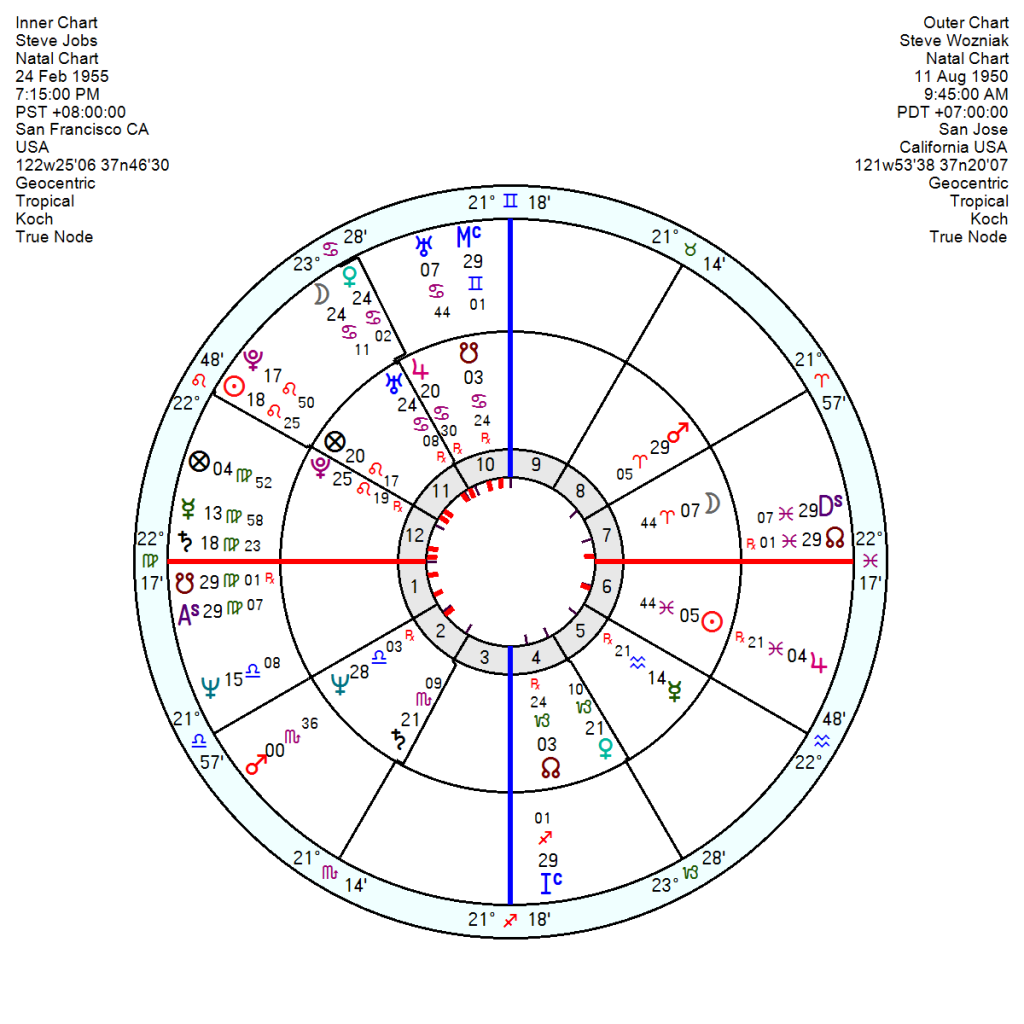
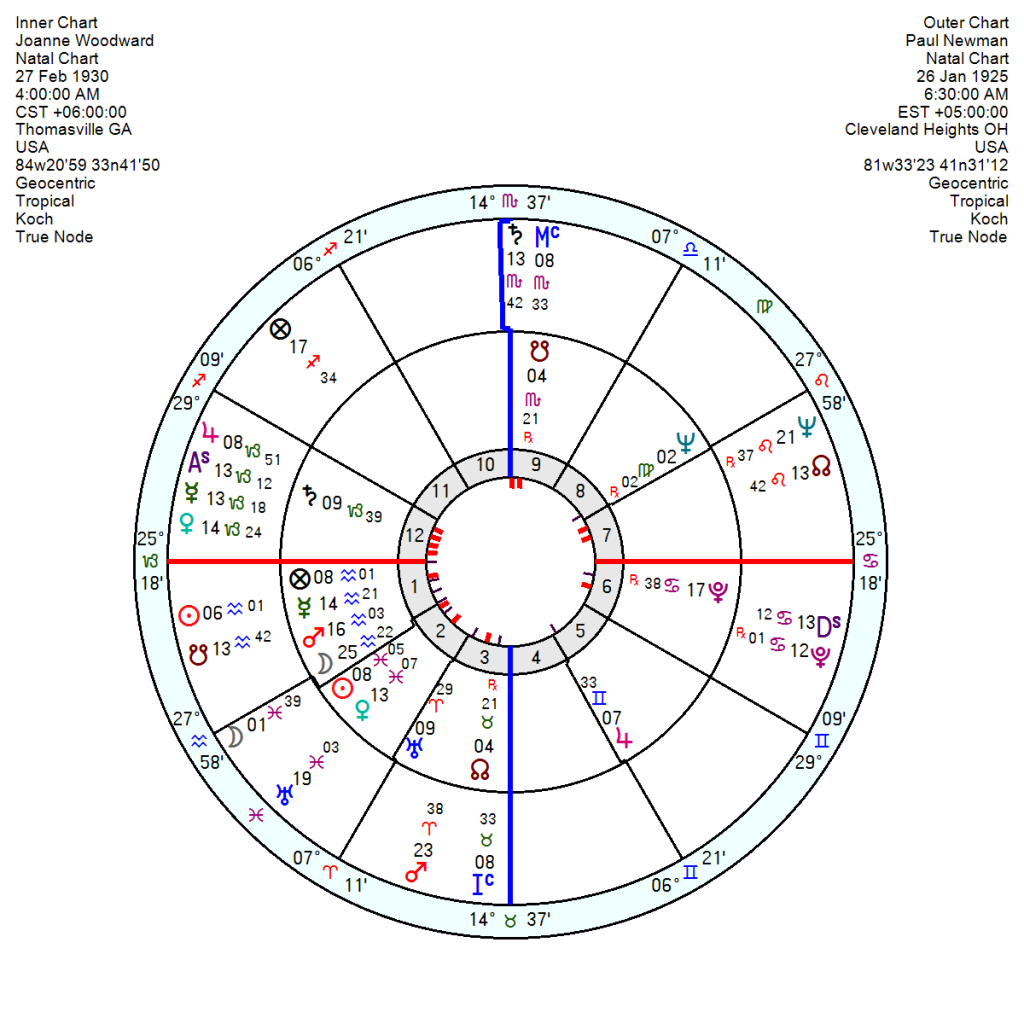
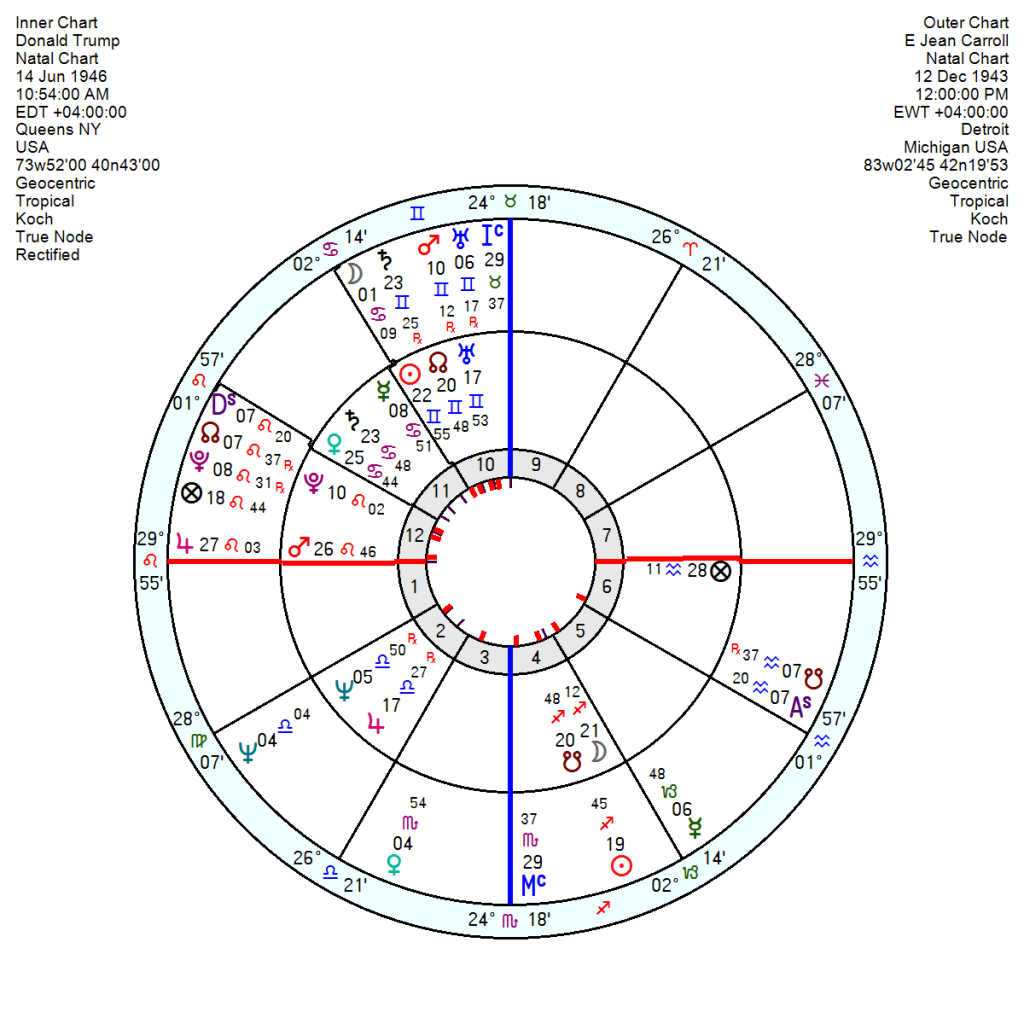
Synastry, comparing on birth chart to another, to understand the dynamics of a relationship is as complicated as human psychology itself.
The first thing is that if an individual is not capable of relating it will not be possible to make a meaningful connection. Which is not to say they won’t get married or have a partner but that partner will themselves have to be damaged enough to submit to a non-functioning, one-sided association.
There are endless permutations of planets to planets and falling in the other’s houses, of which interpretations can be found in websites like Café Astrology or in Sakoian & Acker.
Random thoughts: Sun to Venus brings a harmonious bond but can be over-ridden and obliterated by stronger, negative aspects. Mars cross overs to Venus and Sun can bring a spark of passion and fire, but that can, in time, turn into an argumentative, competitive streak. Initially a Pluto to Venus cross over can bring closeness and intense feelings but eventually will turn to control. Neptune brings dreams and illusions but is slippery, hard to pin down in the Neptune partner and brings disappointment. Saturn is defensive, can be focused more on work/practicalities than feelings but is essential to give a relationship endurance over the long haul.
Planets in the 7th especially the other’s Sun or Moon are ideal. Planets in the 6th suggest hard work will be required to keep it afloat. 11th house brings friendship. 10th house – good for a working relationship and one that thrives on outer appearances. 8th house a deep and not necessarily comfortable connection.
Some examples:
Brad Pitt and Angelina Jolie, at the time a heady togetherness, but still at loggerheads years after splitting up. Her Sun falls in his 7th = good for a partnership. But her Saturn falls in his 8th dampening down intimacy and causing arguments since it opposes his Mars, Mercury, Moon, Venus in Capricorn; and her Pluto falls in his 10th opposition her Mars in his 4th making her overly-controlling and argumentative in their domestic life. Her Mars, Moon, Jupiter in Aries do sit in his domestic 4th conjunct his Jupiter so there would be good feelings initially. His Sun falls in her 5th house of entertainment and children but his Capricorn planets fall in her 6th – so he would be fun as well as hard work.
I would also tend to skip onto the composite chart (merging two birth charts) to see a timeline for the peaks and troughs or outright separation. With a composite Sun opposition Pluto in the Jolie-Pitt match control would always have been a factor; it was never going to be an easy split. There is also a composite yod – Saturn sextile Moon inconjunct Uranus which did not look stable – but it was/is a ‘fated’ relationship that would change both for good or for ill.
Opposites do attract but my impression is that having similar traits does make for glue. The late Queen Elizabeth shared a Moon Neptune in Leo with Prince Philip and her Taurus Sun was conjunct his Venus. So enough sameness or attraction from that. Though they were very different personalities with her excessively Fixed chart with a T square of Leo Moon Neptune opposition Mars Jupiter in Aquarius square Saturn in Scorpio on her Midheaven – and his more Mutable, restless Gemini Sun Mars, Saturn Jupiter in Virgo opposition Uranus in Pisces. His Sun Mars fell in her 5th house of fun and children which would help.
Royal marriages always look seamless from the outside and usually hide a multitude of hurts if not outright sins. But Gunter Sachs study found that Gemini and Taurus were one of the more common combos for long running marriages. Taurus for stability, keen on security and sameness while Gemini, the wanderer, dances round them like a firefly. So their relationship had enough sameness to understand where the other was coming from and enough difference to make them complement each other.
Though their relationship chart had a central composite Saturn opposition Mars indicating one partner had to suppress their identity to make it work – or excessive duty got in the way of indulgence. On the other hand Philip came from a very unstable background so Elizabeth’s steady temperament would help. And in those days divorce was unthinkable in those circles so he knew the marriage would stick no matter what.
Not all relationships are marital matches. Steve Jobs co-founded Apple Computers with Steve Woziak.
Steve Jobs, 24 February 1955 7.15pm San Francisco. Steve Woziak 11 August 1950 9.45 am San Jose, California.
With wonderful syncronicity Woz’s Jupiter in Pisces is conjunct SJ’s 6th house (= work) Sun and SJ’s Sun is conjunct Woz’s 6th house Jupiter. A dream match for working together especially since in both cases their innovative Uranus fell in the other’s 10th house of career.
Woz’s amiable Sun Venus fell in SJ’s 11th for a friendly connection. And SJ’s Moon fell in Woz’s 7th for a good partnership.
The classic relationship match from years back before some of realities came into the open was Paul Newman and Joanne Woodward. He was an Aquarius Sun with a Pisces Moon and she was a Pisces Sun with an Aquarius Moon. His yin to her yang and vice versa is ideal. But his Neptune opposition her Mars and Moon would be undermining and aggravating for her as his drinking took over. Her Saturn in Capricorn was conjunct his Jupiter in Capricorn opposition Pluto so she would be continually pulling back his wilder, over-confident tendencies. Again the composite chart hints at a one-sided relationship with a composite Saturn square Mars, and Mars trine Pluto. It did hang together but at some cost to her career and talents.
ADD ON: E. Jean Carroll who accused Trump of sexual assault and defamation over two law suits and was awarded nearly $100 million in damages. She was born 12 December 1943 and her Saturn is conjunct DT’s Sun, which can be a face-reality aspect, tending to be critical of DT’s behaviour and denting his image. Her Sun is conjunct his South Node and Moon so she would have an attraction for his ‘lower nature’ and need for nurturing. With her confident, attention-attracting Jupiter conjunct his Mars, allowing her to have the assurance to take on his blow-hard denials.
Relationship quotes:
“The meeting of two personalities is like the contact of two chemical substances: if there is any reaction, both are transformed.” Carl Gustav Jung
“For the two of us, home isn’t a place. It is a person. And we are finally home.” Stephanie Perkins
“I know enough to know that no woman should ever marry a man who hated his mother.” Martha Gellhorn
“Every couple needs to argue now and then. Just to prove that the relationship is strong enough to survive. Long-term relationships, the ones that matter, are all about weathering the peaks and the valleys.” Nicholas Sparks,
“How people treat you is their karma; how you react is yours.” Wayne Dyer
“Assumptions are the termites of relationships”. Henry Winkler
“Falling in love and having a relationship are two different things.” Keanu Reeves
“To catch a husband is an art; to hold him is a job.” Simone de Beauvoir
“The heart of another is a dark forest, always, no matter how close it has been to one’s own.” Willa Cather
“The one who loves the least, controls the relationship.”
Robert Anthony

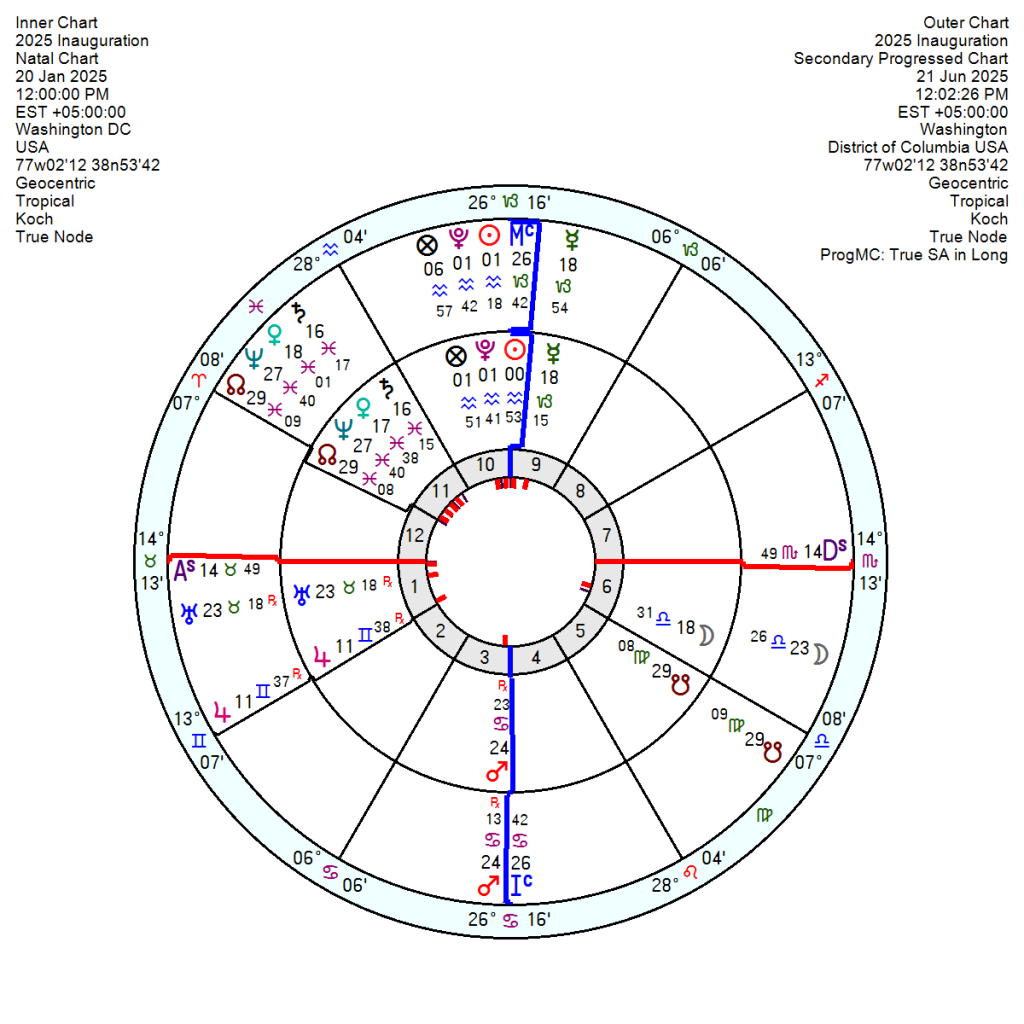

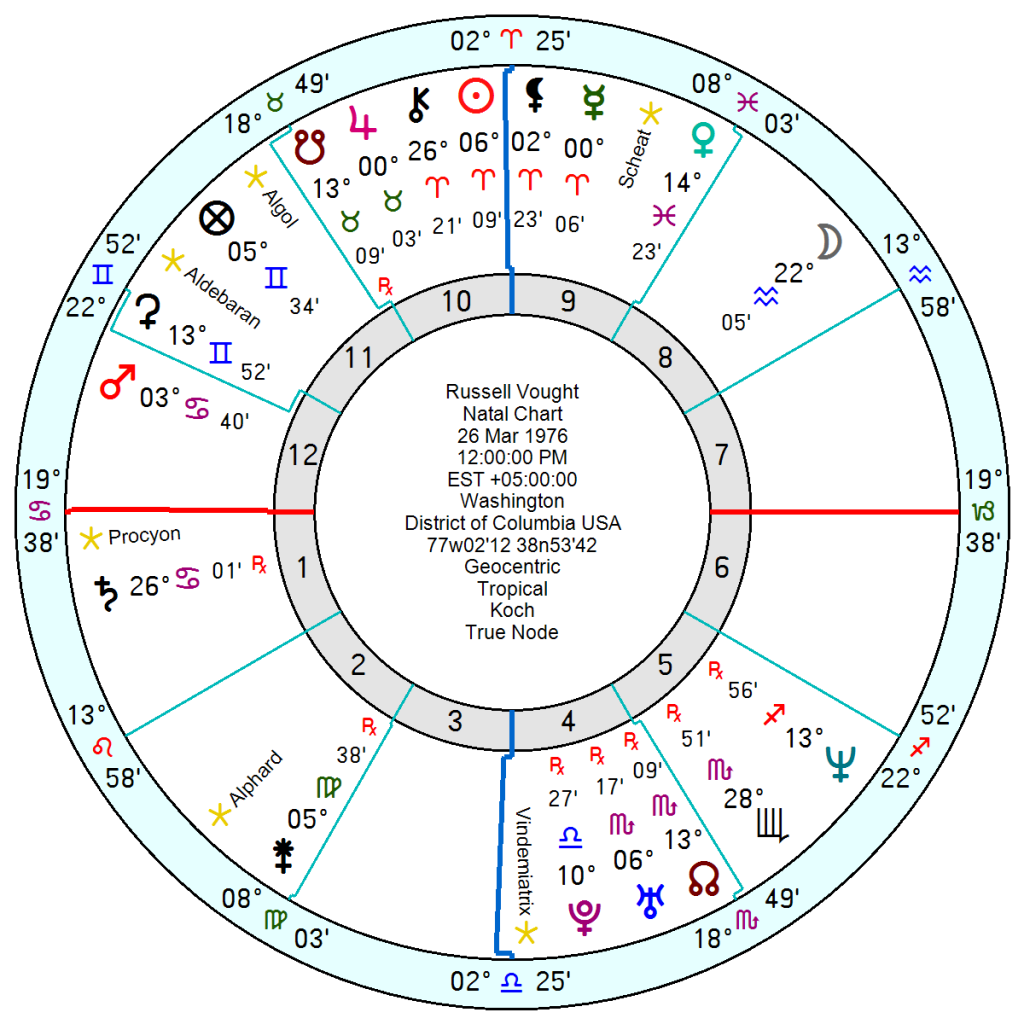


Given that health is a key issue on Trump’s 2nd term Administration chart with a ramped-up focal point Moon in the 6th house of health square Mars opposition Mercury it is no surprise that the slash-and-burn policies cutting back federal health budgets and staff are hitting the headlines.
Appointing Robert F Kennedy Jnr, an anti-vaxxer, as head of the Department of Health, has provoked understandable anguish from insiders. One said: “RFK Jr is a disaster. He is completely dismantling things to the point where the damage is going to become irreparable.”
Decades-old research centres dedicated to preventing chronic diseases like cancer and heart disease are being shuttered. CDC, the Center for Disease Control’s childhood lead-poisoning prevention programme was shuttered. One in two American toddlers showing detectable levels of lead, a neurotoxin that can cause cognitive impairments and developmental issues. The Prevention Research Centres (PRC) programme dedicated to chronic disease prevention in poorer communities in the United States — is to be closed. Established in 1984 the programme is likely to have prevented thousands of premature deaths from obesity, addiction, diabetes and cancer.
Similarly the FDA (food and Drug Administration), experts responsible for inspecting factories to ensure food products are safe, have been hamstrung by the mass firing of staff.
The Trump administration’s demand that federal agencies radically downsize is driven by a key figure in the conservative movement. Russell Vought, the principal author of Project 2025, argues that the federal bureaucracy is an existential threat to the country itself and should dramatically downsize. He is thought to be the one behind the Health departments decisions, more so than RFK Jnr.
The Inauguration Moon will get a sharp wake-up call when the Progressed Moon closes the square to Mars by this time next month. There may be other global issues involved, but in the background health is looming as a crucial problem.
The USA 4 July 1776 11am Philadelphia chart has Solar Arc Sun moving through the 6th house moving to square Mars and oppose Neptune in 2026/27. The USA Sibly chart, 4 July 1776 5.10pm has tr Uranus conjunct the Solar Arc Neptune both in the 6th house – and both being rattled by tr Uranus in final degree Taurus on and off into mid 2026. Plus the Solar Arc Midheaven being conjunct Uranus in the 6th. Both charts and the Inauguration home in strongly on 6th house issues.
Russell Vought, 26 March 1976, is a ruthless Sun Aries opposition Pluto square Mars in Cancer; with his Sun trine Neptune plus Pluto makes him mega ambitious; and an opportunistic Jupiter opposition Uranus.
He looks to be on a downward slide from 2026 onwards in a major way as tr Neptune Saturn square his Mars and continue on in hard aspect round his Cardinal T square until 2028. He will battle on against the odds in 2026 but his elastic will be pretty much gone thereafter.
RFK Jnr, 17 January 1954 5.32pm (unverified) Washington, DC, looks stuck and agitated now with his SA Saturn opposition his Uranus; rattled by arguments in 2026 and completely stuck by 2027 with his SA Pluto conjunct his Saturn.
The CDC, 1 July 1946, is showing the strain and pain most in 2027 to 2029 – so the attritional damage will peak perhaps as a public health crisis emerges.
The FDA, 30 June 1906, in a spiral of uncertainty at the moment with SA Saturn conjunct Neptune; equally shows 2027 onwards as the real catastrophe.
The Dept of Health, 11 April 1953, has a yod of Jupiter sextile Mercury (Moon) inconjunct Saturn Neptune in Libra opposition Sun Venus in Aries. The yod has moved by Solar Arc putting the SA Neptune Saturn opposition SA Sun Venus on cue to be challenged by tr Neptune Saturn in square – hinting at it being pushed onto a different trajectory.
Trump with tr Pluto just entering his 6th may alter his outlook on health services – not that he will go short of a doctor but it might (!?!) knock some sense into his head.
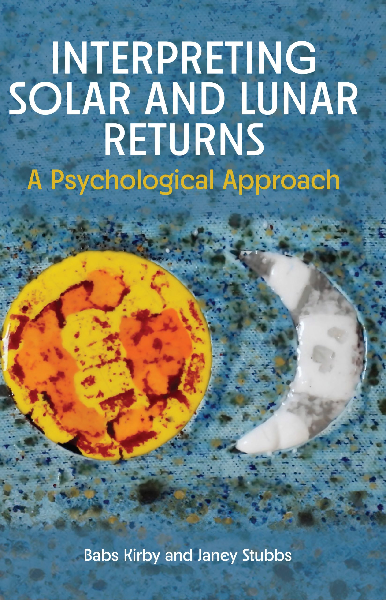
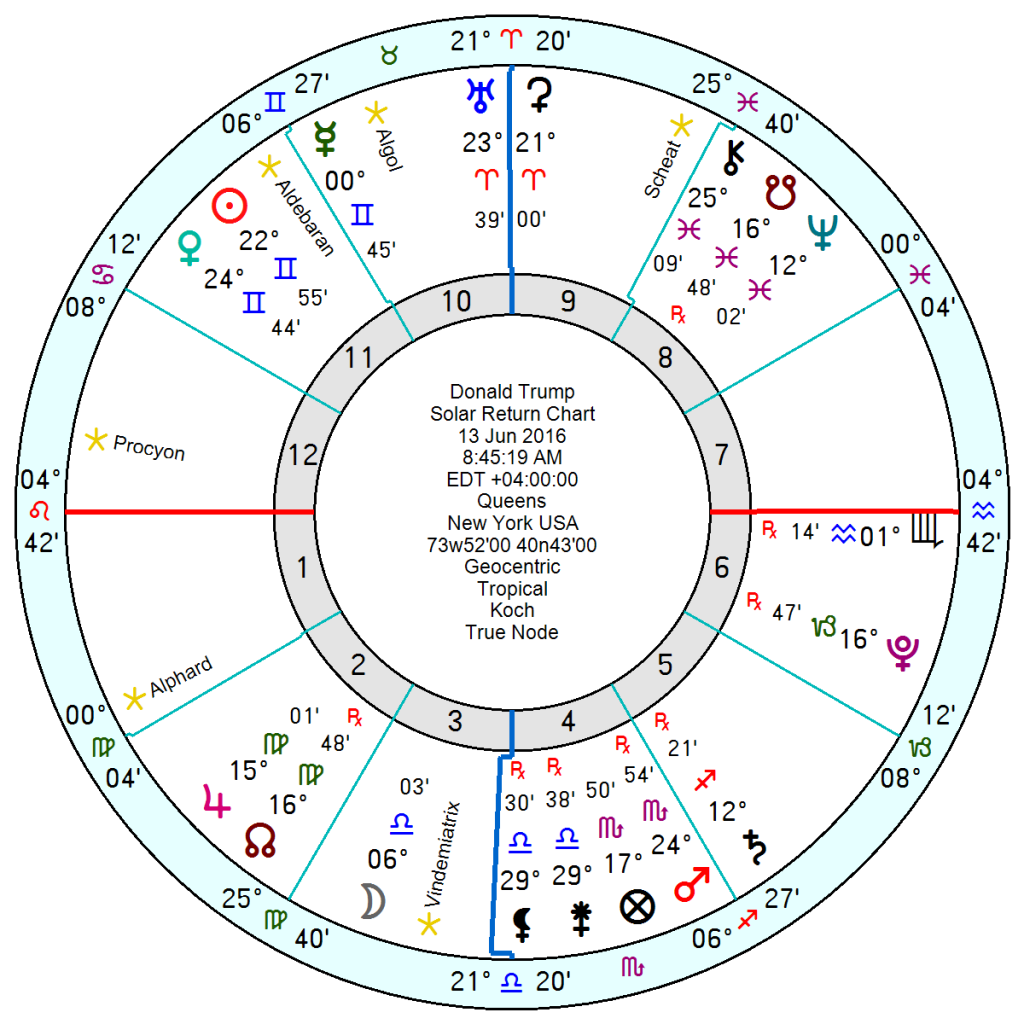
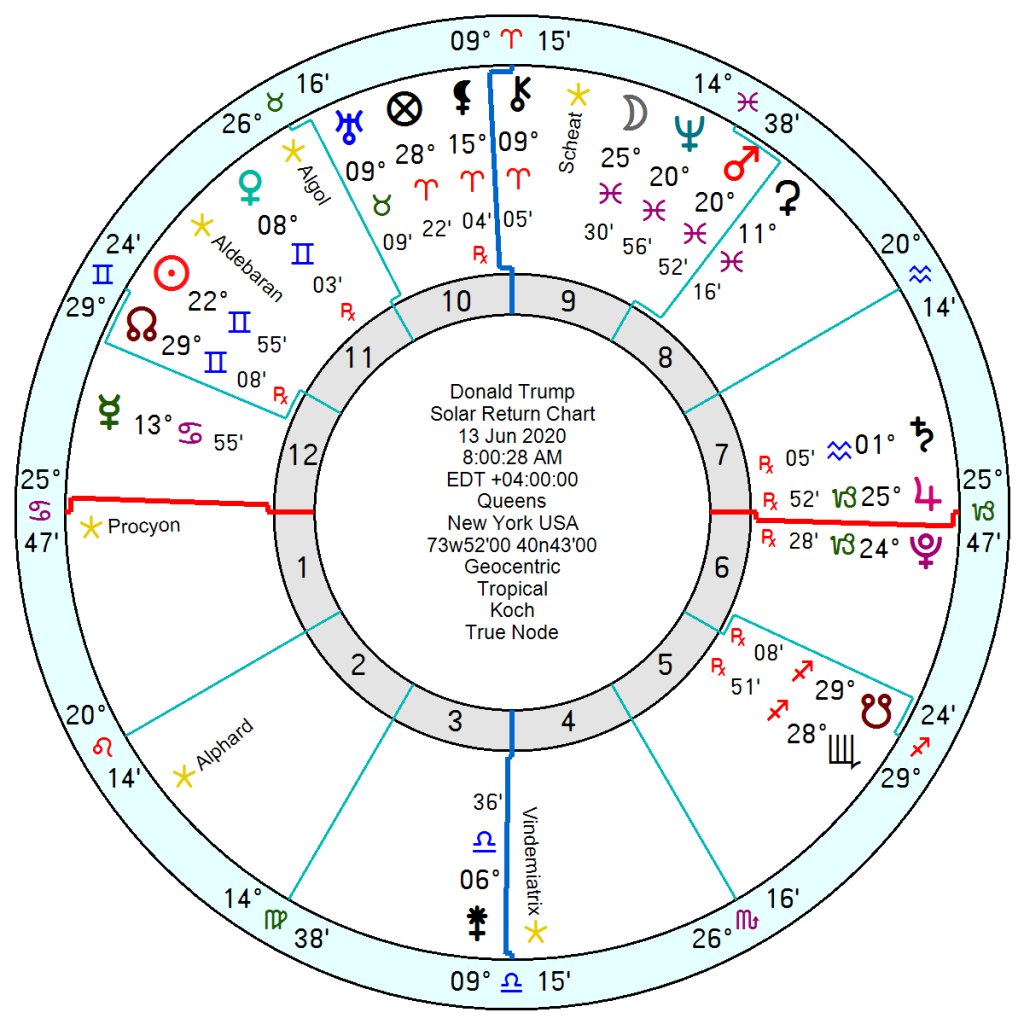
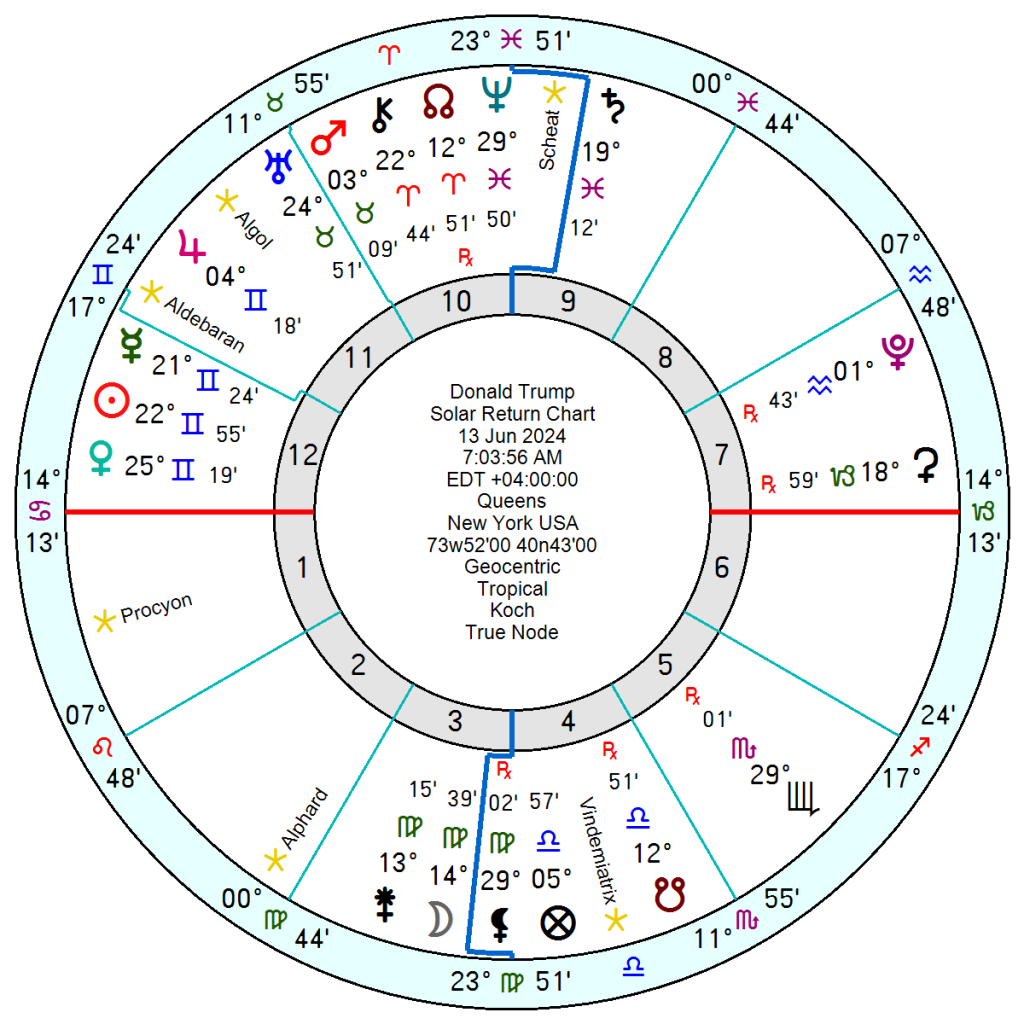

Solar Returns drawn up for the moment the Sun returns to its natal place have been a consuming fascination since the days of respected astrologers Johannes Kepler and William Lilly in the 16/17th century.
But for all the weight put on them as indicators of the year ahead interpretations are not always obvious. ‘Nuanced and subtle’ are how Babs Kirby and Janey Stubbs, authors of a newly reprinted book Interpreting Solar and Lunar Returns: A Psychological Approach, describe the process of extracting a theme for the year ahead.
The Sun’s house position and aspects are pinpointed as the most important factor with a run down of all 12 houses and aspects. Next is the Moon with its aspects within the Return chart as well as to the natal chart, and the importance of its progressed positions through the coming year. Then the comparison between the natal and return chart with particular emphasis on the Solar Return Midheaven/IC and Ascendant/Descendant contacts.
There is much of value to be gleaned from this well-written and clearly laid-out listing of meanings of house and aspects. With example charts to study. Lunar Returns (month to month) are also described as well as Mercury, Venus and Mars Returns.
Personally I still find Solar Returns oddly obscure and find Lunar Returns a good deal more helpful for a quick scan of the up and coming.
I do slightly wonder whether they work better for some individual charts than for others – though I have no idea why that would be. King Charles had his SR Sun in the 8th when his mother died which makes sense and his SR Sun in the ‘entertainment’ 5th for his Coronation year. The year he was diagnosed with cancer his SR had a busy 3rd house Sun Mars in Scorpio with Saturn in his 6th house of health.
Tony Blair had his Sun in the 6th square Jupiter when he was first elected in 1997 with Mars on the Midheaven – lucky and ambitious with hard-work being the order of the day. Not sure I would have predicted a rip roaring success from that as a standalone indicator.
As an example – and assuming Trump’s birth time from his birth certificate is accurate – his Solar Return for June 2016 had an 11th house Sun square Jupiter and an 8th house Neptune; with Uranus on the Midheaven. An 11th house Sun would focus his energy on the wider social group which kinda makes sense, though does not leap out immediately as king of the castle time. The SR Midheaven was opposition his natal Jupiter. There were much clearer indicators from Solar Arcs etc to indicate a success.
His Solar Return for his defeat in 2020 also had an 11th house Sun square Neptune Mars Moon in the 9th; and Jupiter Pluto Saturn in his 7th. I know you are not supposed to read Solar Returns the way you read a natal chart – bit still??
His 2024 SR prior to his win put his Sun in the 12th, supposedly a time for solitude and introspection, a time of self-sacrifice and sensitivity. His SR Sun is square Saturn and Neptune in Pisces for discouragement and confusion. His SR Ascendant is admittedly conjunct the USA Cancer Sun which may mean something. His Solar Return for this coming year looks like a grandstanding success with his Sun on the Midheaven and Jupiter in the 10th with an influential Pluto in the 5th. Hmm, I wait to be persuaded.
I am still ambivalent about their usefulness and hit-and-miss quality – though I stand to be corrected if others have a different take.

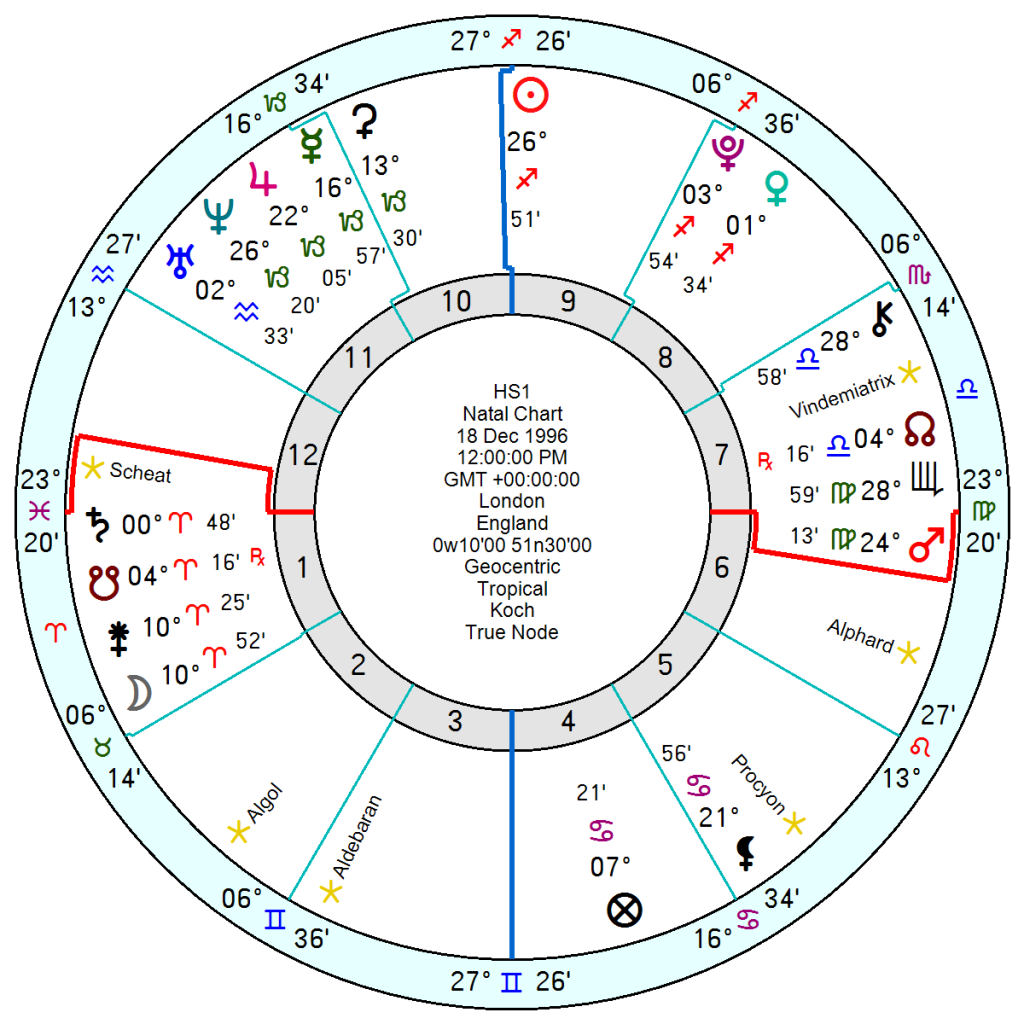
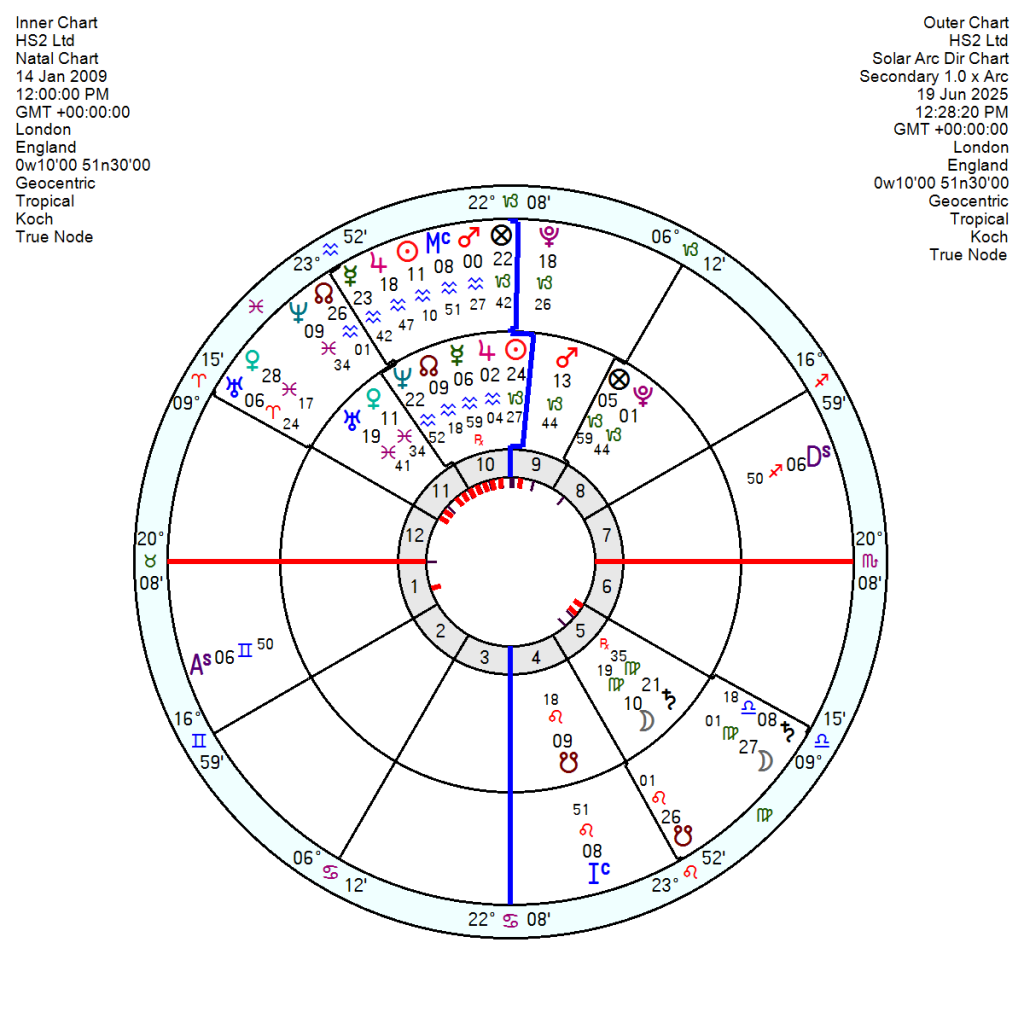

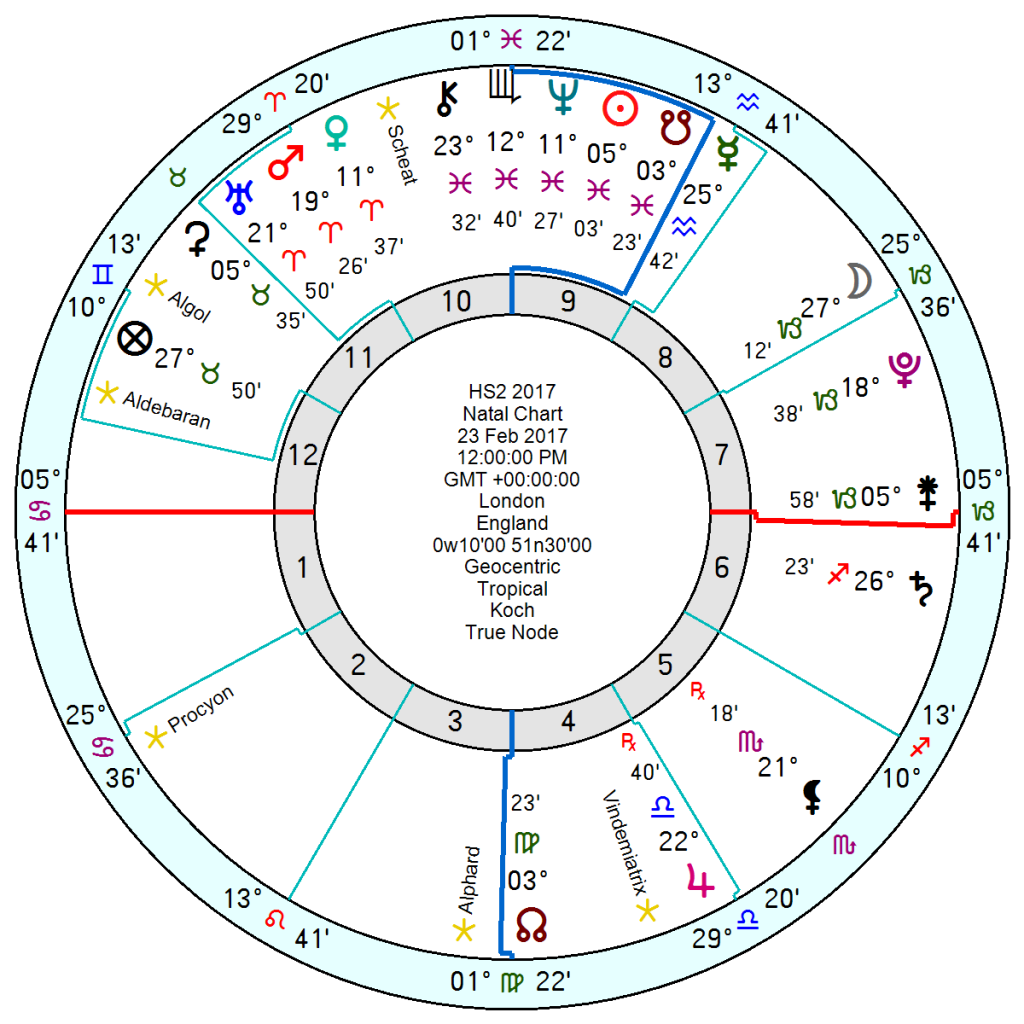
The HS2 (High Speed Train 2) project has been labelled ‘a complete failure by the British state and its politicians’ and an ‘appalling mess’, fuelled by political puff and short-termism – the project has become a farce.’
Peter Mandelson’s insider confession about how Gordon Brown and his cabinet came to approve HS2 in 2010 in the aftermath of the post-banking crash era makes depressing reading portraying it as an attempt not to be outdone by the Tories in their enthusiasm for a shiny new big project. The cost estimates were “almost entirely speculative”, wrote Mandelson, but “the vision was exciting” and “we were focusing on the coming electoral battle”.
Later Tory leaders, especially Boris Johnson, did no better as he pushed the button to proceed in 2020, knowing HS2 only made sense if built in full. After 18 months the Leeds and then Manchester sections were cancelled.
A recent review found that interfering politicians doomed HS2 from the start with no plans hammered out before proceeding and costs spiralling to an estimated £1bn for every mile of the high-speed railway. The business model evidently meant contractors had little to no incentive to hit cost targets and ran rings around the arm’s-length body, HS2 Ltd.
Taking a step back to HS1, the 109.9-kilometre (68.3-mile) high-speed railway linking London with the Channel Tunnel, came about after similar high speed rail links had been built in France and Belgium. The Channel Tunnel Rail Link Act 18 December 1996 set it in motion and after a few problems the second section was opened by 2007.
The 1996 chart has a stalwart Saturn in Aries conjunct South Node trine Pluto Venus sextile Uranus; with a Sagittarius Sun square Mars and Mars trine Jupiter Neptune. The Sun square Saturn on the North/South Node opposition may be significant.
HS2 Ltd, the incorporated company set up by the government, state funded, on 14 January 2009 had a Capricorn Sun and Mars trine Saturn in Virgo; with Saturn opposition Uranus.
The two subsequent charts of 10 January 2012 and 23 February 2017 also had a heavy concentration of Cardinal planets which would take the brunt of the transiting Pluto in Capricorn (and tr Uranus in Aries) throughout the decade plus since its inception. The charts are not especially ill-starred but they would have been pounded by tr Pluto in Capricorn, causing delays, possibly financial corruption, political failure and the like.
So it may be regarded as an epic failure both financial and political which can be laid at the foot of the Pluto in Capricorn years.
Now that Pluto has moved on into Aquarius, an attempt is being made to get a grip of the fiasco. Some faint hope may come on the HS2 Ltd 2009 chart with tr Pluto conjunct the Jupiter from last year (when the present damning review was put into gear) and the Solar Arc Mars conjunct the Jupiter in 18 months time – both of which could hold hope of a reboot – of sorts.

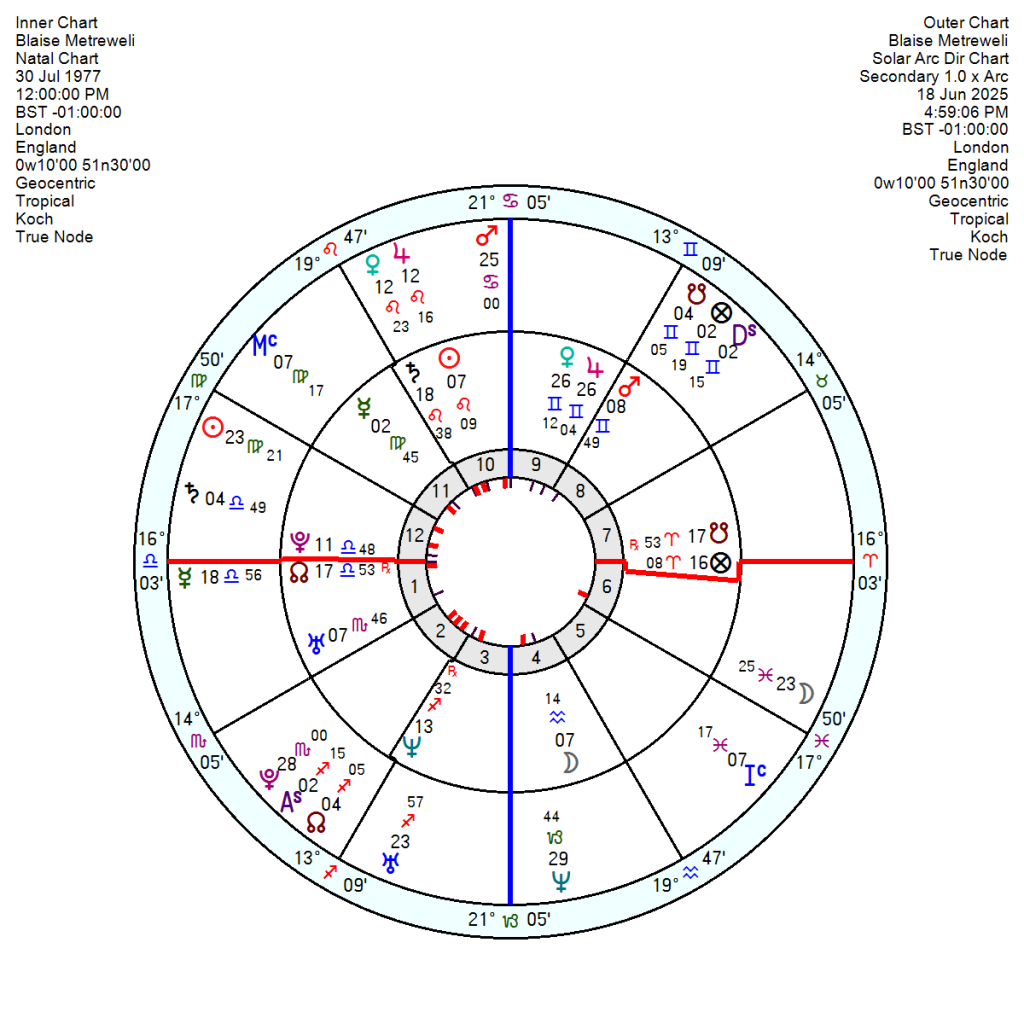
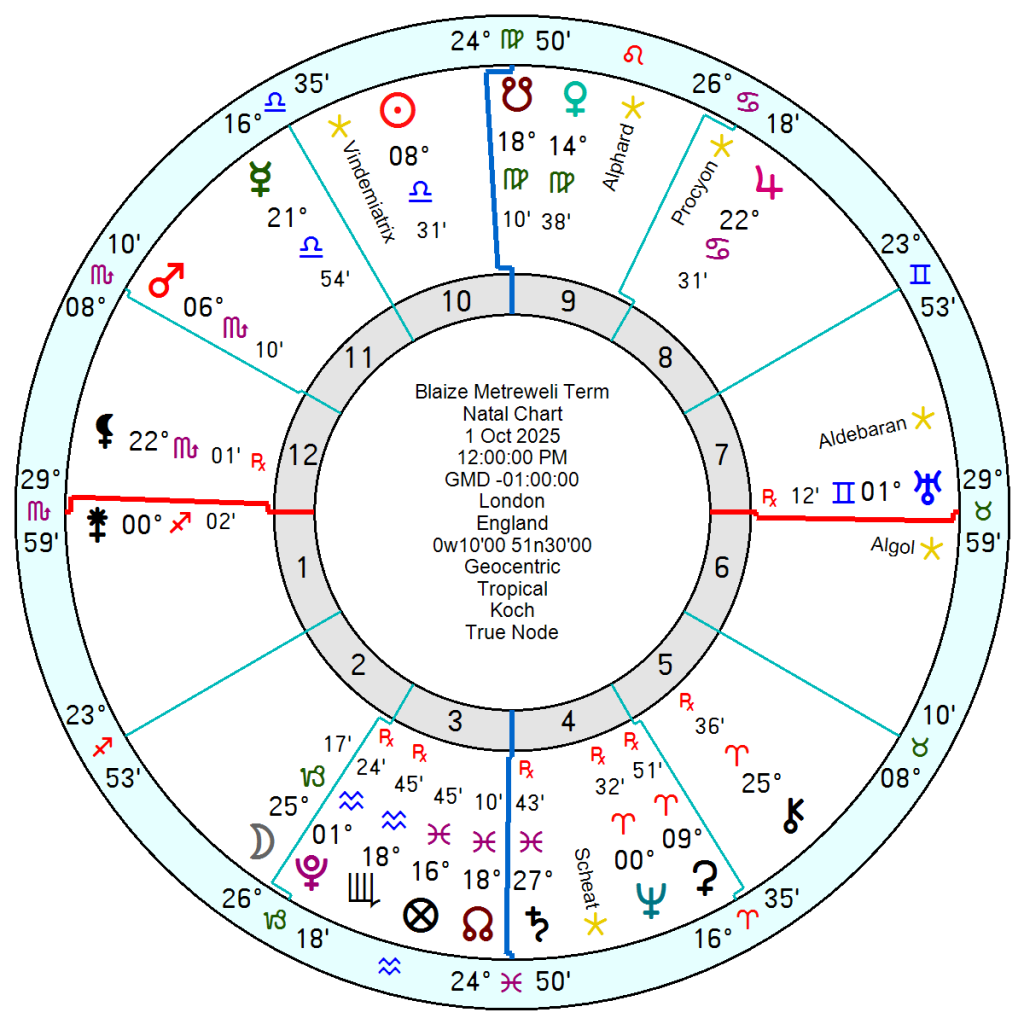
Blaise Metreweli is to become the first woman to head MI6 (the UK’s Secret Intelligence Service) from 1 October. [Played by Judi Dench in Bond as ‘M’]. She is currently Director General “Q” – head of the technology and innovation division which has the crucial task of gathering intelligence overseas to improve the country’s security, stop terrorism, disrupt the activities of hostile states and bolster cyber-security.
She was born 30 July 1977 in London and spent some of her childhood in Hong Kong where her medical father worked. She studied anthropology at Cambridge, has had director level roles in MI5 and spent most of her career working in the Middle East and Europe.
An independent, unconventional Sun Leo square Uranus, she has an Air Grand Trine of a determined Mars in Gemini trine Pluto trine an Aquarius Moon with her Mars opposition Neptune, her Moon opposition her Sun and Pluto opposition her South Node. Three Kites and a plethora of sextiles from her Grand Trine make her a thinker, communicator, tough, used to danger, super-ambitious, lucky and talented.
There is nothing showing up as major jeopardy until later this decade 2027 to2029.
Her Term chart, 1 October 2025, has another Air Grand Trine, so suits her cerebral temperament. A Libra Sun is trine Pluto trine Uranus with the Sun opposition Neptune. Neptune is not always useful in an organizational chart but for the smoke-and-mirrors ethos of the intelligence branch it may be exactly what is needed. Pluto squares Mars in Scorpio for daring-do and dastardly-deeds or at least facing them. Not overly grounded or practical but for an increasingly cyber-heavy future that may be an advantage as dead-drops al la George Smiley (Tinker Tailor) become history.
There are a few hints of challenges with tr Uranus square the Saturn/Pluto midpoint this November and April 2026 (could be involved in a war situation – hopefully from afar) with some uncertainties and disruptions through 2026/27. But again the high-risk patch is more 2027/28.
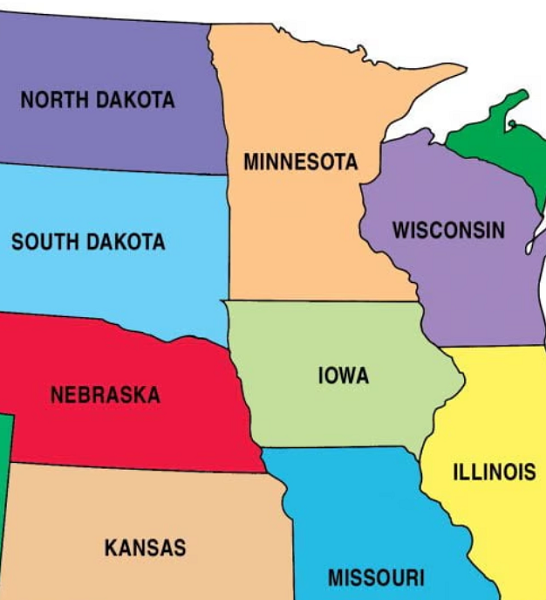

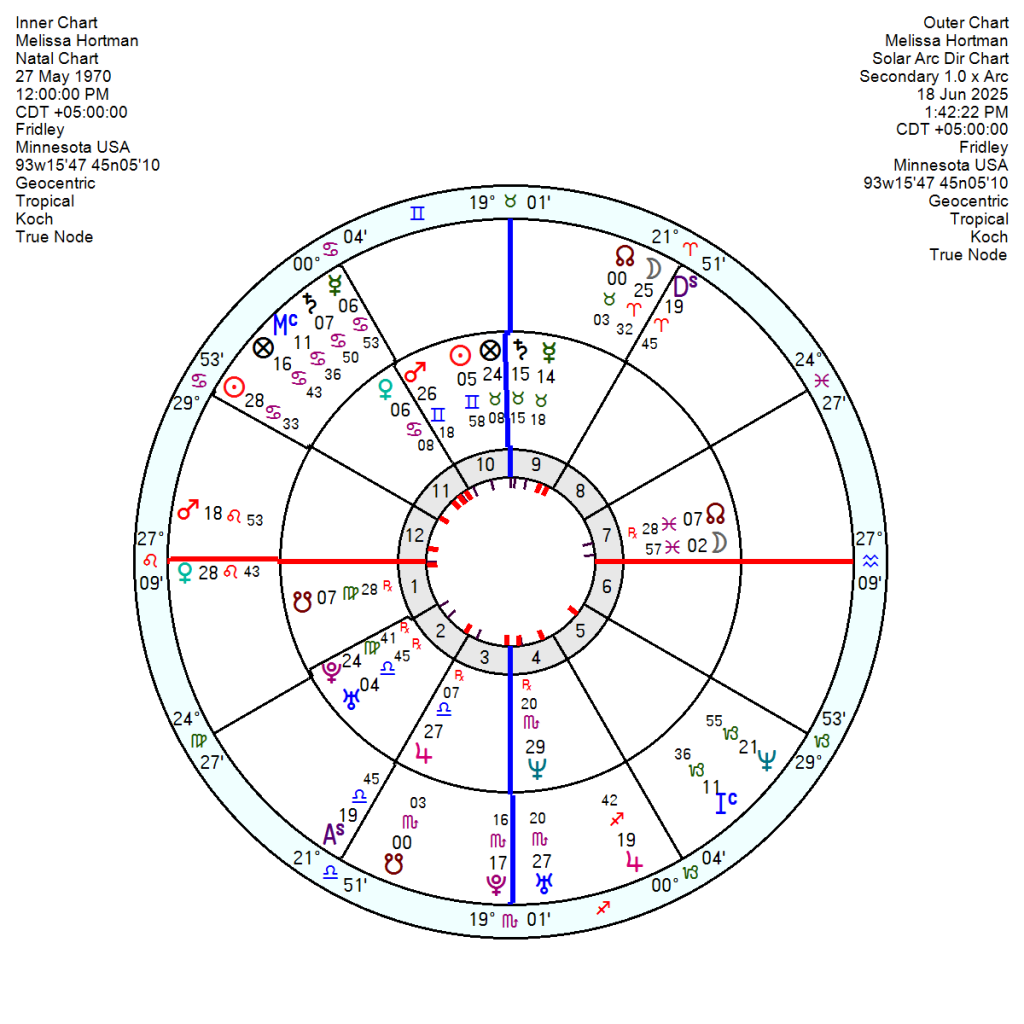
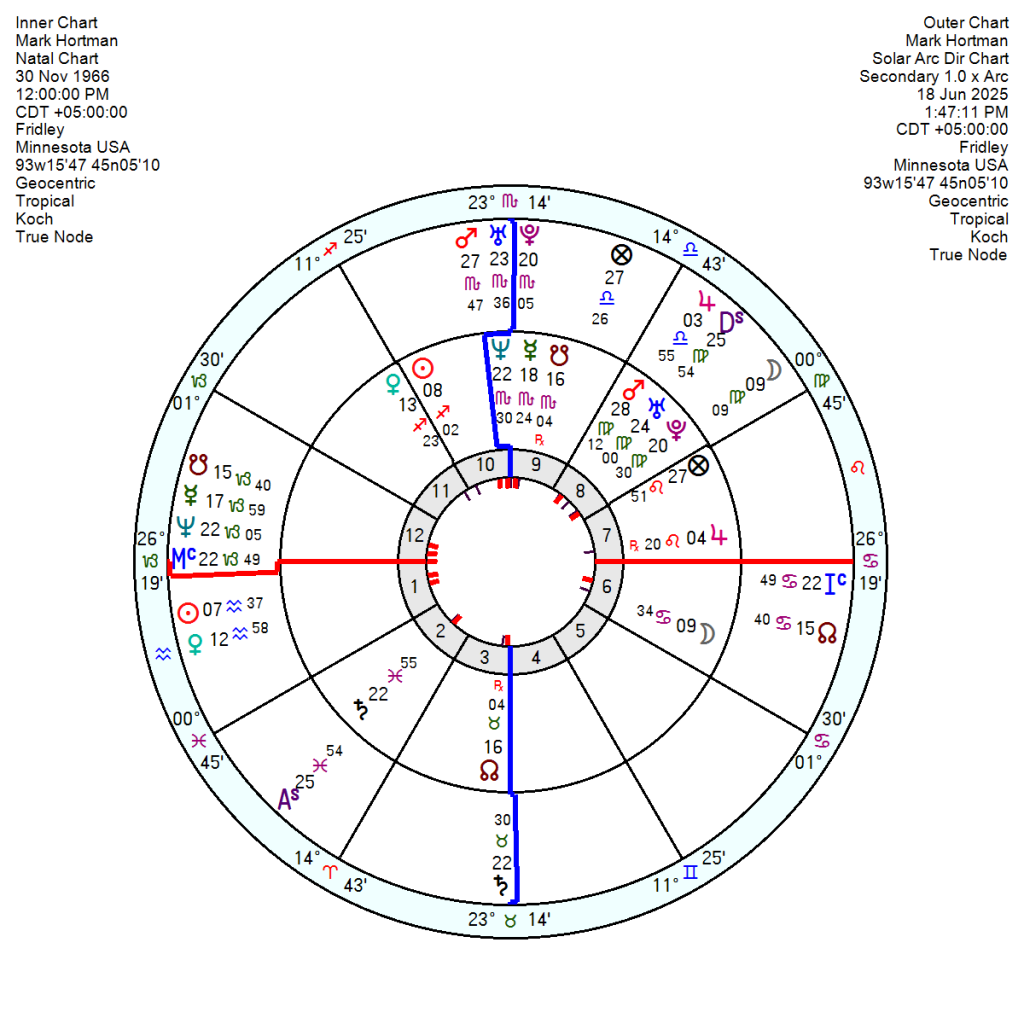
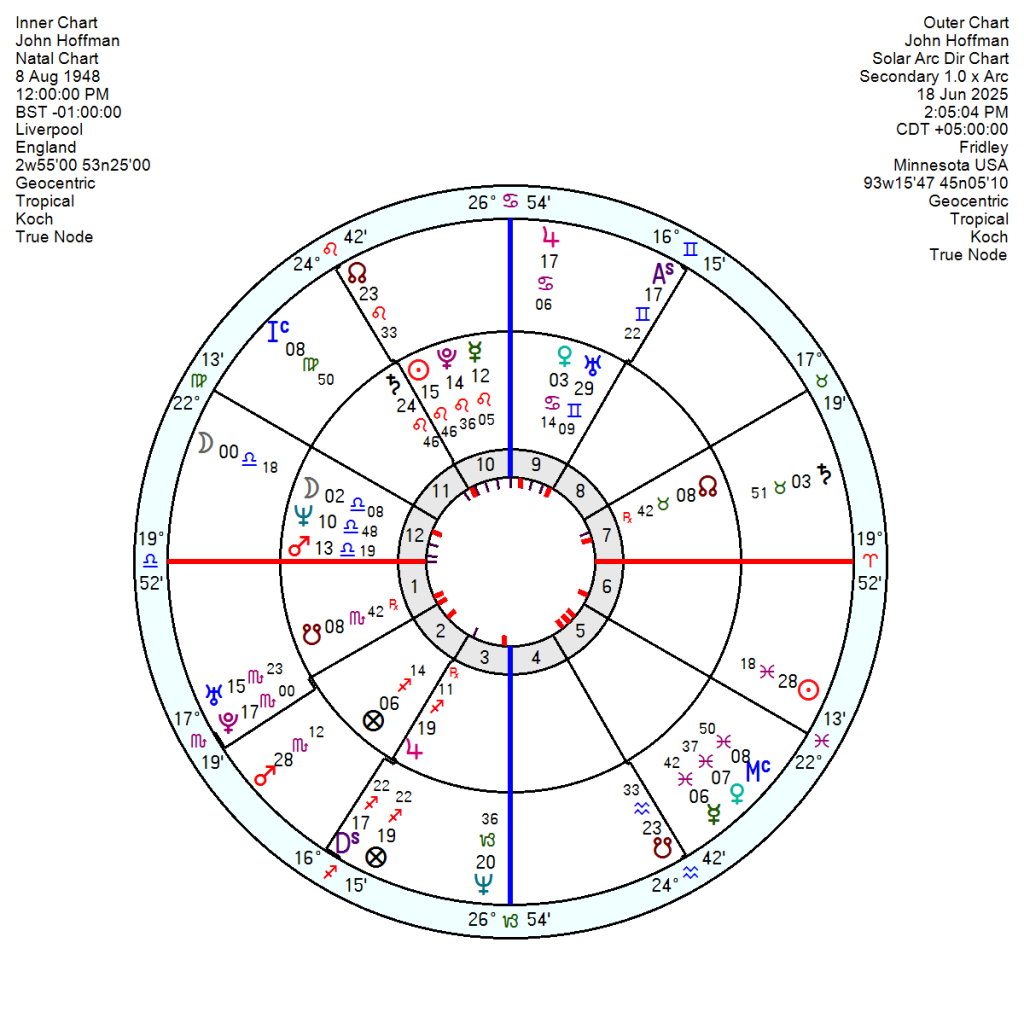
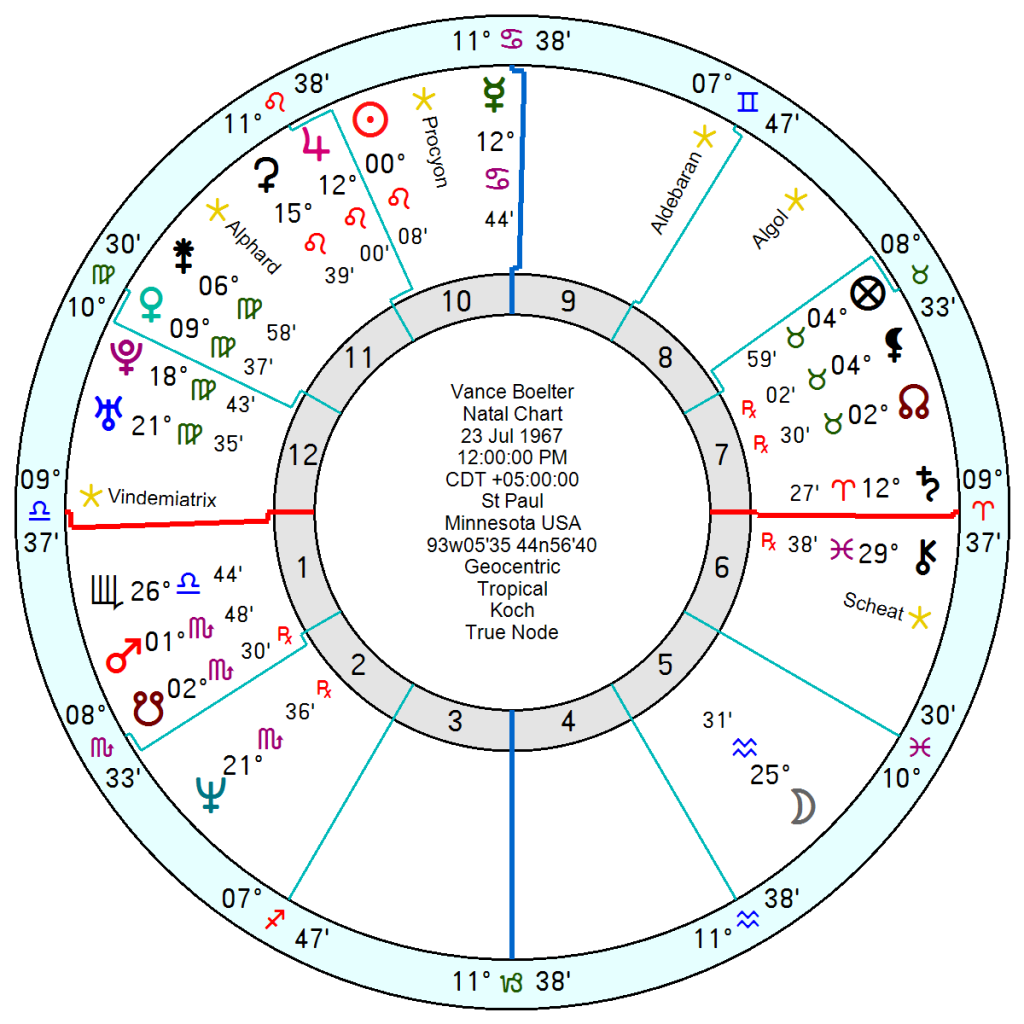
The Minnesota assassination of Congresswoman Melissa Hortman and her husband; and the shooting of Senator John Hoffman and his wife which has left them severely injured occurred on the exact Mars square Uranus (conjunct Algol) on June 14th.
The Minnesota state chart, 11 May 1858, was exactly on its Uranus Return – with the tr Uranus Algol square tr Mars also triggering its Jupiter, Algol, Uranus opposition Mars in Scorpio – so it was always going to get the full brunt of the explosive Mars Uranus influences.
The previous eclipses located to Minnesota also had Jupiter marked on the axis – the March Solar Eclipse with Jupiter conjunct the IC; and the March Lunar Eclipse with Jupiter conjunct the Descendant.
Melissa Hortman, 27 May 1970, a lively Sun Gemini trine Uranus, opposition Neptune – had her Solar Arc Uranus and her natal Neptune both late degree Scorpio square Venus in late Leo – so was also rattled by the prevailing celestial winds. As was her husband Mark, 30 November 1966, an upbeat Sun Venus in Sagittarius trine Jupiter in Leo whose Solar Arc Mars was in late Scorpio for the shocking end to their lives.
John Hoffman, still in hospital, 17 January 1965, a Sun Capricorn trine Mars in Virgo also coincidentally had his Solar Arc Mars in late Scorpio catching the hard aspect from the transiting Mars Uranus Algol square as well.
Vance Boelter, 23 July 1967, who has been arrested for the crimes is a Sun Leo square Mars and South Node in vengeful Scorpio, with Jupiter in Leo trine Saturn in Aries. He allegedly dressed as a police officer and drove in a car that resembled a police squad, leaving behind a list of names after he fled, mostly Democratic elected officials and abortion rights activists who he allegedly wanted dead.
His relationship chart with Melissa Hortman had a composite Mars in late Leo, possibly on the exact degree of the Mars square Uranus.
A tragic coincidence of destinies.

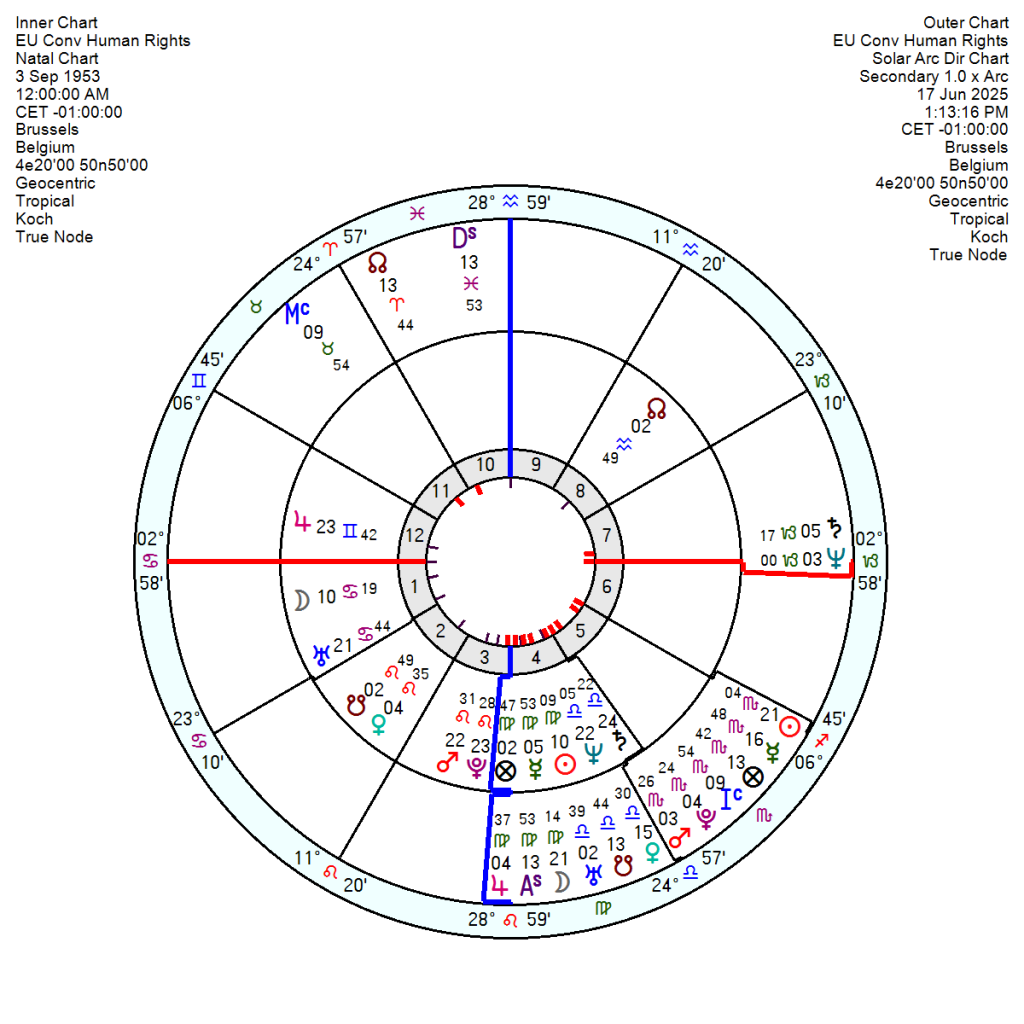
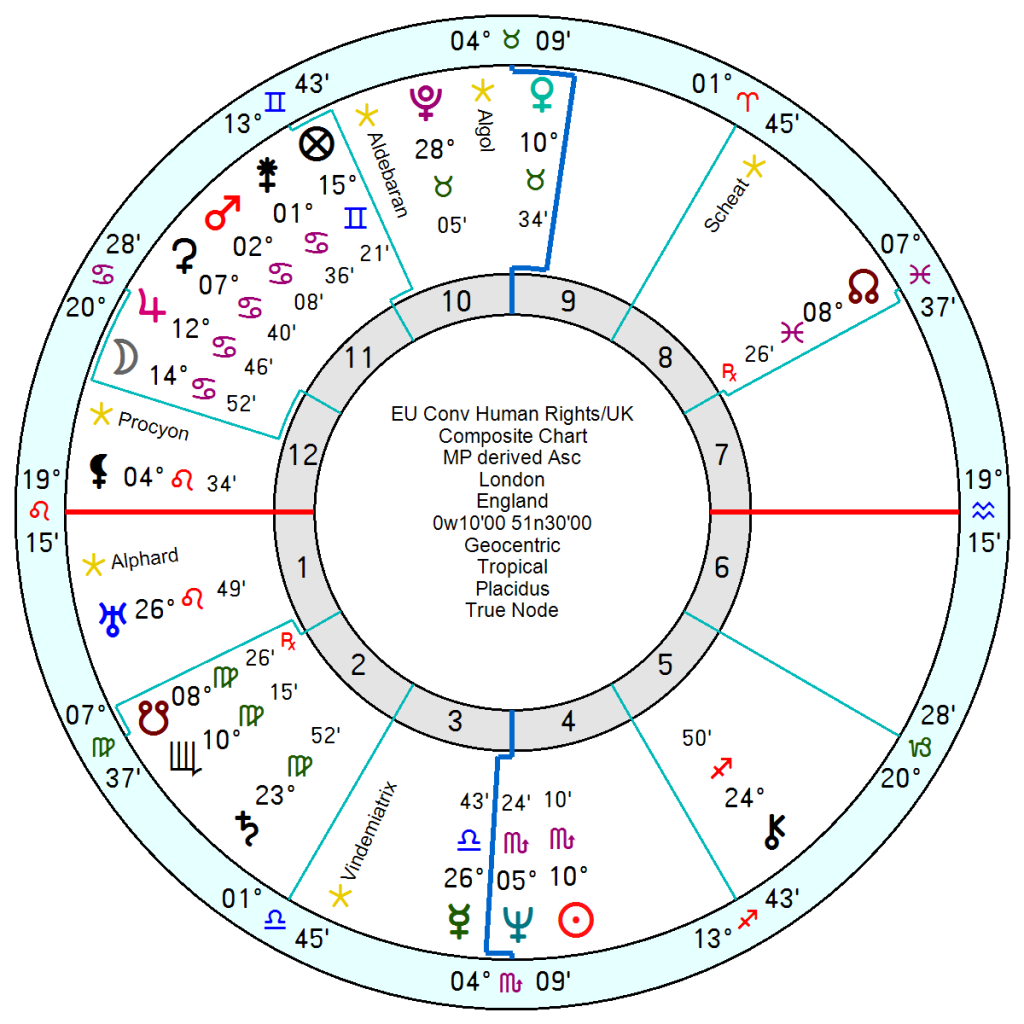
Increasingly bizarre court decisions taken under the guise of the European Convention of Human Rights, allowing murderers and rapists to avoid extradition on specious excuses are leading to pressure for reform.
The ECHR, agreed after World War 11 by Churchill, Adenauer, Mitterrand and others came into force on 3 September 1953 in part as a defence against Stalinism. Any person who feels their rights have been violated under the convention by a country can take a case to the court. Judgments are binding on the states concerned and they are obliged to execute them. Only Russia and Belarus are not signatories.
Recent cases have allowed criminals to stay in the UK because their removal might upset their children. Another in today’s Times refers to a murderer who was sentenced to 14 years in jail in Brazil for repeatedly raping a five year-old girl who fled to the UK before he could be convicted and was on Interpol’s most-wanted list. A British judge refused Brazil’s extradition request on the basis that it would violate his Article 3 rights.
It is clear it needs to be reformed or the UK Faragists will win the argument for a complete withdrawal. It came into effect when there was a fearsome Mars Pluto conjunction in Leo on the midpoint of Jupiter in Gemini trine Neptune Saturn in Libra – a curious mixture of enlightened thinking and bullying domination. The Saturn Neptune’s drive for better society backed up by an immoveable Mars Pluto. There is a Sun Mercury in Virgo and a 1st house caring Cancer Moon as well.
The central Trine has moved by Solar Arc to catch the tr Saturn Neptune square the Solar Arc Neptune Saturn in 2026/28; tr Pluto to square the SA Mars Pluto also in 2026/28 and tr Uranus square the SA Jupiter in 2026/27/28. Plus tr Pluto conjunct the 8th house North Node and then opposition the Venus so any changes will be hard fought and difficult to accomplish.
The UK’s relationship chart with the ECHR is being undermined by tr Neptune square the composite Mars exactly now and into 2026; alongside a major upheaval from tr Uranus conjunct the Pluto square Uranus through the winter into mid 2026. With further challenges from 2026 for several years with tr Pluto square the composite Neptune and then Sun and Venus.
There could be an exit late in the decade though only after protracted pressure for real change.

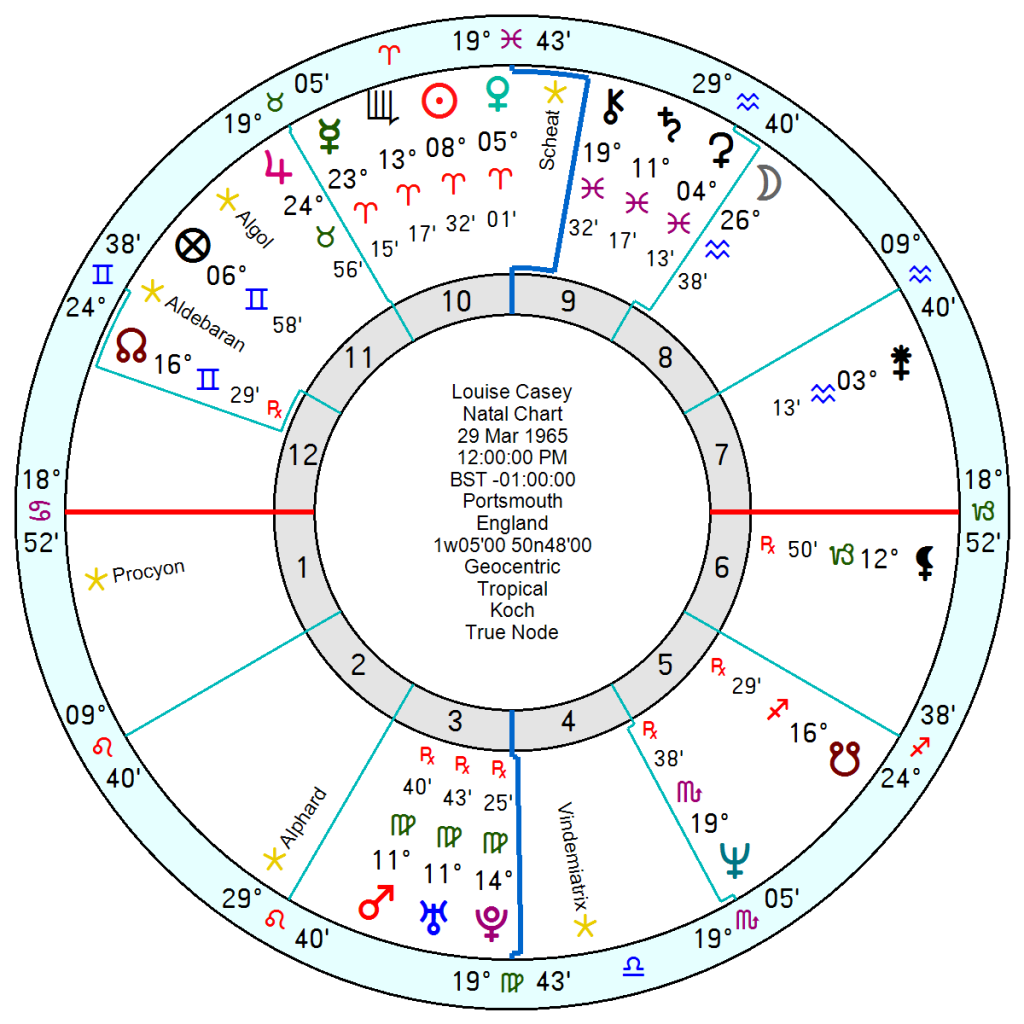
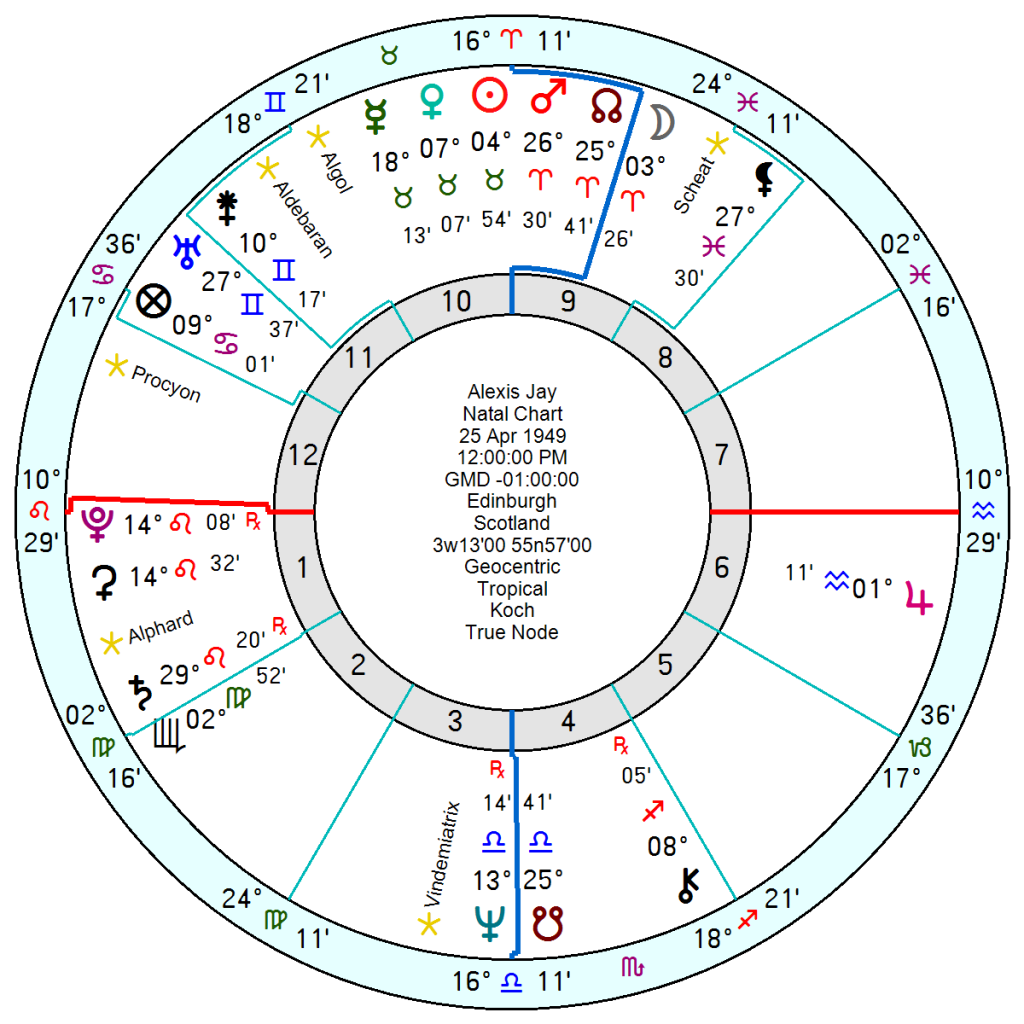
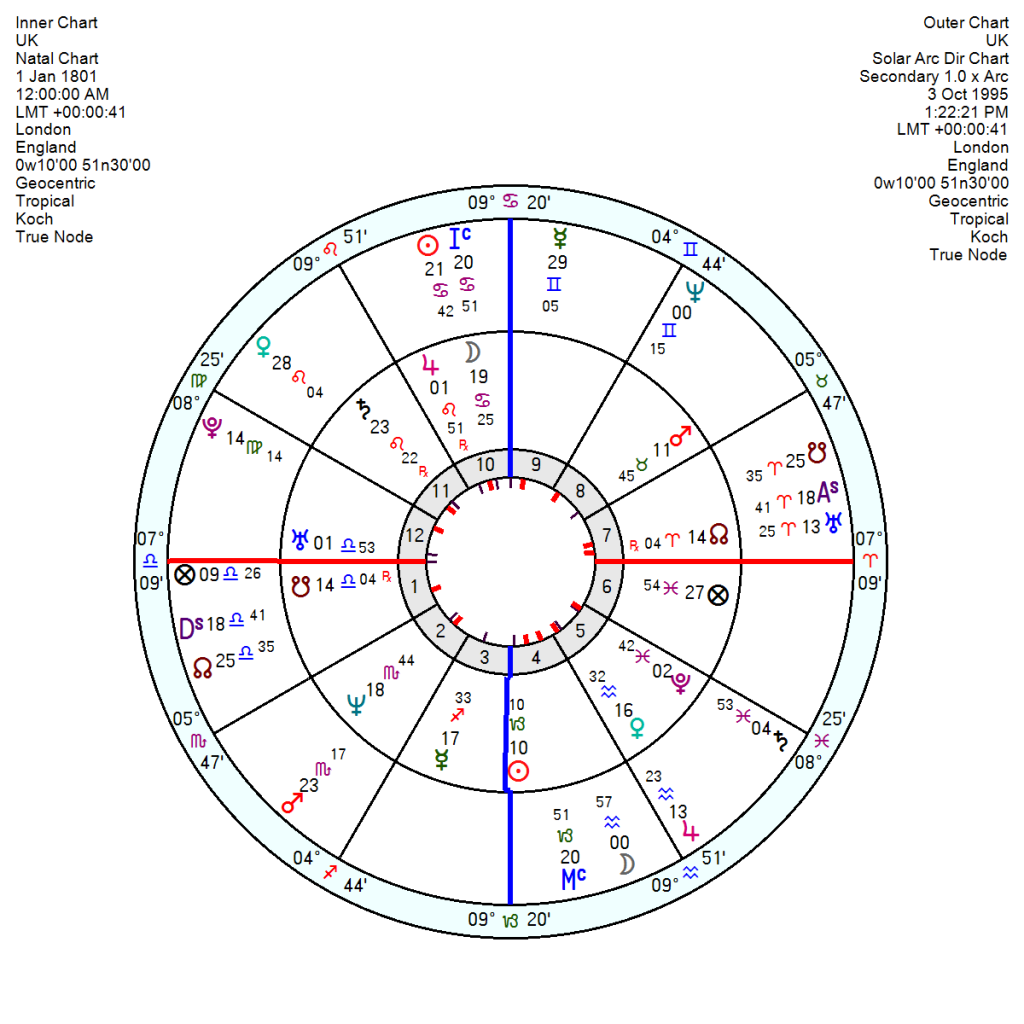


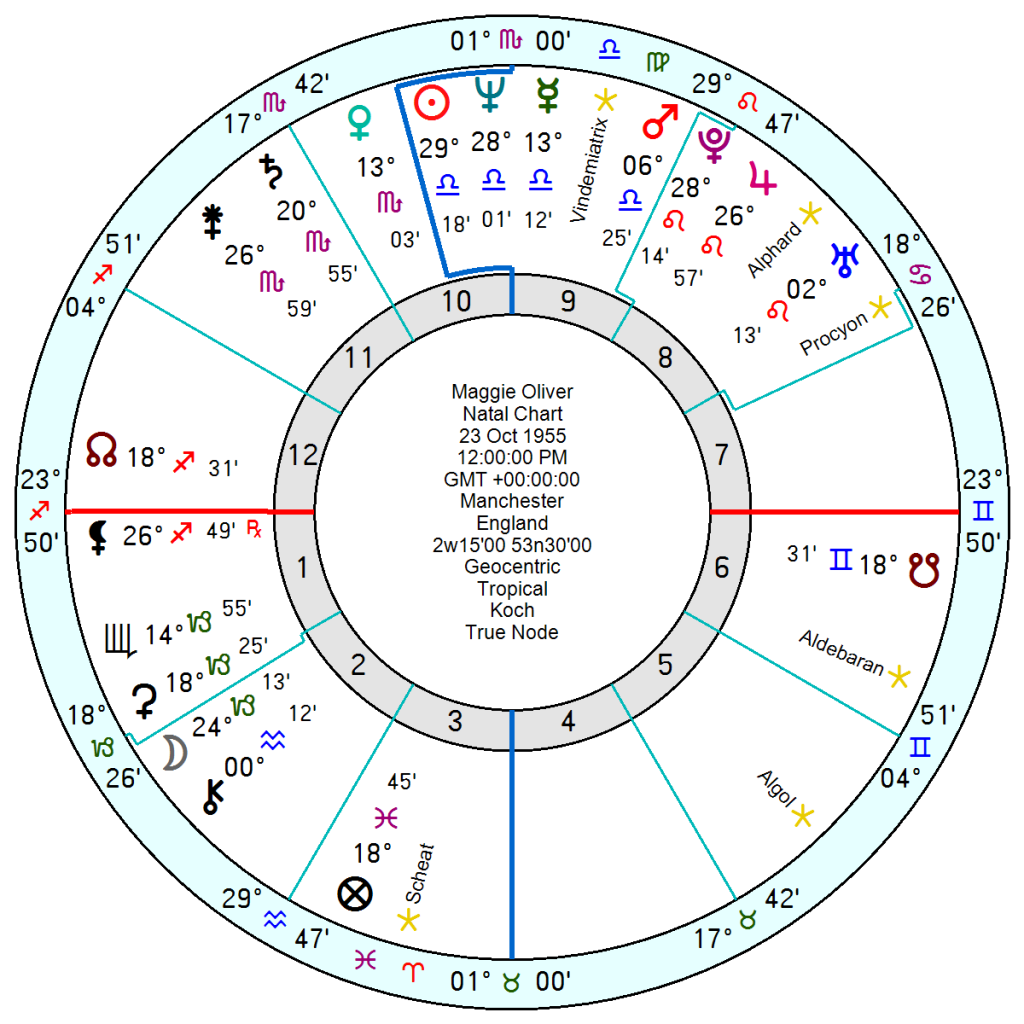
UK Home secretary Yvette Cooper has issued an “unequivocal apology” over the failure of the British state to protect young girls from predatory grooming gangs over 16 years, as she confirmed a full national inquiry into the scandal. The recent Casey Inquiry found a large proportion of the perpetrators were men from Asian ethnic backgrounds. A culture of “blindness, ignorance and prejudice” led to repeated failures over decades to investigate. Asylum seekers and foreign nationals are involved in a “significant proportion” of live police investigations into child sex grooming gangs.
Lady Casey said she had been “outraged, shocked and appalled” at the treatment of victims by authorities that were supposed to be protecting them. “We are talking about multiple sexual assaults committed against children by multiple men on multiple occasions, beatings and gang rapes,” Casey added.
This recent report comes 10 years after she wrote a damning report into the culture of denial at Rotherham, South Yorkshire, where at least 1,400 children were sexually abused by grooming gangs between 1997 and 2013.
Downing Street said Sir Keir Starmer believed that “the grooming scandal was one of the greatest failures in our country’s history despite previously having criticized those calling for an inquiry as “jumping on a bandwagon” and “amplifying what the far right is saying”. Elon Musk was one of the most recent voices to make an impact on the subject. The inquiry will be time limited and build on the work done by Alexis Jay, who carried out an independent inquiry into child sexual abuse.
Whether even a shortened inquiry (three years!) will do much to overcome the ‘analysis paralysis’ of previous inquiries such as Grenfell, the infected blood scandal, the ongoing Covid inquiries and earlier child abuse investigations remains to be seen. Alexis Jay who completed a seven year inquiry with a report whose recommendations were barely acted on, pleaded for “action not words.”
Baroness Louise Casey, 29 March 1965 Portsmouth, England, is a crossbench peer with a background in Shelter, the Rough Sleepers’ Unit, the Anti-Social Behaviour Unit, Troubled Families, leading a review of culture and standards in the Metropolitan Police in London following the murder of Sarah Everard as well as into Rotherham child abuse failures.
She has an upfront Aries Sun conjunct Venus; and a heavy-duty Mars Uranus Pluto opposition Saturn square North Node in Gemini which will give her the depth and courage to go into the darkness and not be deterred by what she finds. Mars Pluto Saturn is a tough combination.
Alexis Jay, 25 April 1949, Edinburgh, who wrote the earlier child abuse report, is a steady, determined Sun Venus in Taurus square Pluto; with Mars in Aries conjunct North Node trine Saturn in Leo sextile Uranus. Again she has a heavily aspected Mars tied into the North Node.
Everything has been said before on this subject see: previous post 4 January 2025 – Child Sexual Abuse – too terrible to face ++ ultra-liberal fascism ++ ‘social and state failure’ ++ foreign males commit more sex crimes.
But I wondered about the UK’s 8th house Mars being triggered by the Solar Arc Uranus conjunction at the moment – opening up the sewers. Transiting Pluto in Scorpio in the 1980s/to late 1990s brought a good deal of buried sexual horror to the surface, culminating in the horrific Fred/Rosemary West trial.
Keir Starmer’s Government chart also has Mars Uranus in the 8th which may reflect financial instabilities but could also relate to the resistance to facing up to the grooming gangs. Especially since the Government chart has a ‘caring’ Sun, Moon, Venus in Cancer in the 10th = wanting to look good, but that trines Saturn and sextiles Mars Uranus which has an entirely different feel. There is an intense, emotionally fraught Pluto in the 5th house of children opposition Mercury, making this one of the key issues of Starmer’s Term. Not that Labour are alone in turning a blind eye since the Tories did no better.
My final thought is that ethnicity and religion are really not the key factors – it is more the deeply entrenched tribal background of immigrants from misogynistic cultures which are about four hundred years behind ours, which is the problem.
Add On: Two other women who stood up to be counted.
Former Labour MP Ann Cryer who attracted media attention, and death threats, for speaking out against forced marriages, honour killings, calling on immigrants to learn to speak English before entering the country, and for being amongst the first people to talk about the issue of gangs of Asian men sexually abusing children in Yorkshire. Born 13 December 1939 she is a Sun Sagittarius square Mars in Pisces, and square Neptune opposition Jupiter, and trine Saturn South Node in Aries. Outspoken, pro-active, idealistic, self-reliant with a confident Jupiter trine Pluto.
Maggie Oliver, 23 October 1955, a former Detective Constable with Manchester Police, who was a whistleblower for exposing the poor handling of the Rochdale child sex abuse ring case by her own force and had to resign.
She has a Sun Neptune conjunct in Libra sextile a confident Jupiter Pluto in Leo; with her Pluto in an ultra-determined conjunction Mars. Not a lady who does things by halves.
ADD ON: June 22 Sunday Times Matthew Syed.
“The missing link in the grooming gangs report: cousin marriage.”
“Many abusers are linked not just by blood but by loyalty to their clan, a system unfamiliar to westerners.”
“Cousin marriage sustains close-kin networks which incentivise clan members both to dehumanise out-group victims and to suppress knowledge of criminal activity to preserve family honour.”